Château de Chambord - an exaggeration of an exaggeration
last update: 20 Nov. 2019

Introduction
In the summer of 2018 we decided to visit Chambord, and as Wikipedia confirmed, it's one of the most recognisable château's in the world. François Ier (1494-1547) decided in 1519 to build one of the largest châteaux in the Loire Valley as a 'hunting lodge' (pavillon de chasse).
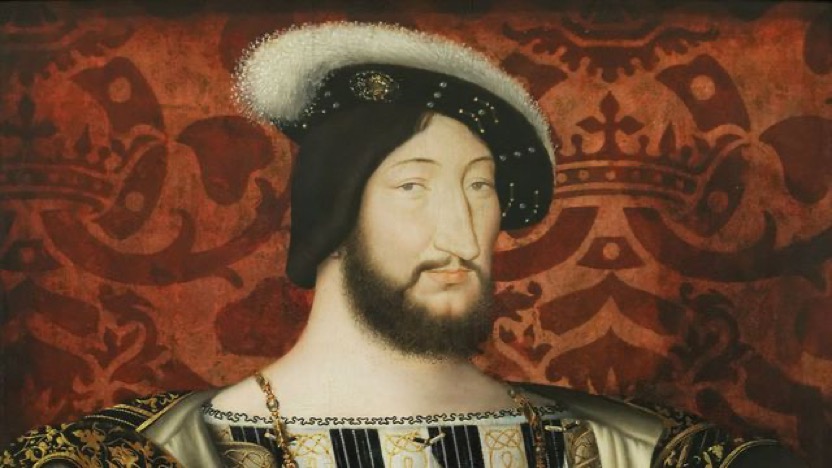
Every guide book tells us that Chambord is built in the Renaissance style, has 440 rooms, 282 fireplaces, 84 staircases (including a famous double-spiral staircase), 128 meters of façade, 800 sculpted columns, 11 different kinds of towers, 3 different types of chimneys, all set in a 13,000 acre park and game reserve enclosed within a 31 km long wall.
Interestingly the French version of Wikipedia tells us that Chambord has 156 meters of façade, 426 rooms, and 77 staircases of which 13 are 'grand'. We also learn that the area of the park is in fact 13,442 acres (5,525 hectares), that the wall is 32 km long (and 3.25 meters high), and that the park is the largest walled park in France. Many documents mention that the park of 5,525 hectares (about 55 million square meters) is about the same size as Paris 'intra muros'.
As we have mentioned Chambord is a Renaissance building, built by a very Renaissance-style King, François Ier. But we should not forget that Europe was constantly at war, and if that was not enough there were numerous peasant revolts as well. The French were involved in the Italian War (1521-1526), the so-called Little War of Hungary (1530-1552), another Italian War (1536-1538), and yet another Italian War (1542-1546), and so on. Charles V (1500-1558) ruled both the Holy Roman Empire (which someone once said was neither Holy, Roman or an Empire) and the Spanish Empire, and at the same time there was the Reformation and Jean Calvin (1509-1564). And not forgetting the invention of the rifle and the arquebus (15th century) and the printing press ca. 1439.
It would appear that François Ier only spent a total of 72 nights in the château (another report says 109 nights), and upon his death it had already cost 444,070 lives. As a hunting lodge it was not designed to be used for longer visits. With massive rooms, open windows and very high ceilings it was impossible to heat. Normally left empty, all the furniture, wall coverings, and every 'domestic need' including food would have been brought in for each hunting trip. It is said that the King would travel with as many as 2,000 people, so one can imaging the logistic nightmare.
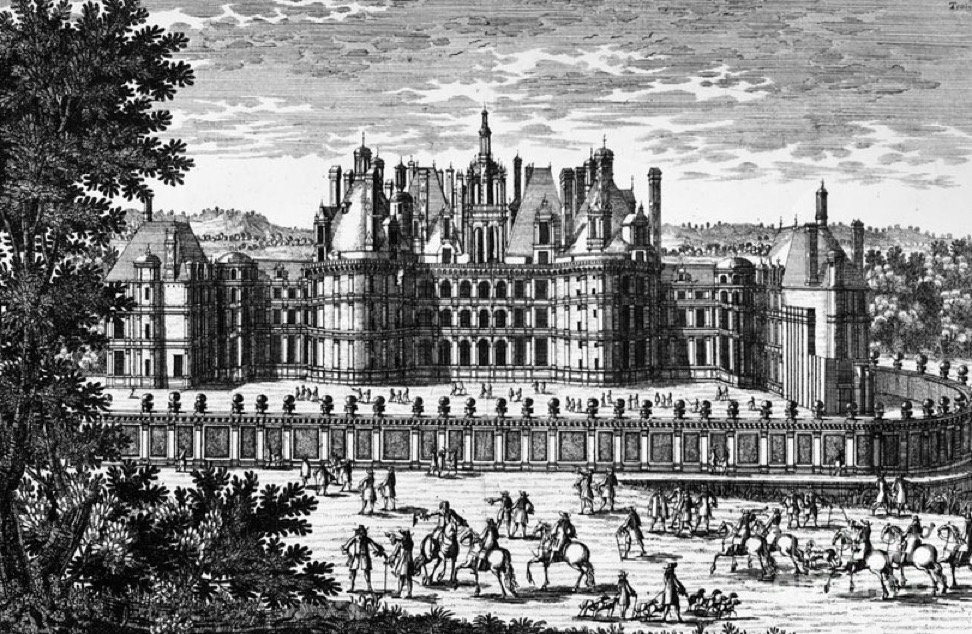
After the death of François Ier in 1547 they say that the château was not used for more than 80 years. Later there was some restoration work done and Louis XIV (Roi Soleil) furnished the royal apartments and had built a 1,200-horse stables before again abandoning the château in 1685. Later still the château was lived in, but with the French Revolution the story goes that it was completely emptied in 1792 and again abandoned. There appears to have been a few failed attempts to restore something of its past glory, but finally it became the property of the French State in 1930. In the 1960's it was Georges Pompidou's Musée de la Chasse, which was later transferred to Paris in the Hôtel de Guénégaud. Later that 'hôtel' became the home of the Foundation de la Maison de la Chasse et de la Nature and the collection was divided, part to the Musée de la Chasse et de la Nature and part to the 2nd floor in Chambord. So, at least according to Wikipedia, the paintings, 'tapisseries' and contemporary art collection seen in Chambord belongs to the Foundation.
As mentioned above, with the French Revolution the royal châteaux were emptied of the furnishing and fittings (either destroyed or sold). However, many of the more useful pieces ('bureaux', etc.) were kept, and there has been an ongoing process of locating the items (across more than 600 sites), restoration them, and returning them to the different châteaux. This process has been ongoing in all of the great French châteaux, for example, a large gilded bronze lantern was removed from Hotel Matignon and returned to the Château de Versailles.
Since 2014 Chambord and the French Mobilier National have an agreement to allow furniture and 'objets d'art' to be loaned 'back' to Chambord. The French national collection of furniture includes 75,000 period tables, seats, etc. and 3,500 tapestries. The result was that 50-odd pieces dating from 1775 have been returned to the château for the apartments of Louis XIV (1638-1715), and numerous other pieces ('banquettes', paintings, carpets, 'paravent', etc.) have been found and placed back in Chambord.
In fact the idea to furnish Chambord was at least in part driven by the idea that people would not be willing to pay to see an empty château. The result is a little bit 'messy'. The château was lived in over many different periods, and filling the building with furnishing, etc. from different periods can detract from the image of Chambord as a 'Renaissance' château.
As you would expect the French version of Wikipedia has a far more extensive history of the château, where we learn that during its construction there were 1,800 workers on site and that it needed 220,000 tonnes of stone.
An important point is that Chambord has all the usual attributes of a medieval fortified castle, for example, a moat, a keep or 'donjon', corner towers, an exterior wall, etc. But being built in the mid-15th century, this type of building had been made obsolete by advances in artillery. Some experts have suggested that François Ier built Chambord with a nostalgic notion of a declining universe of chivalry.
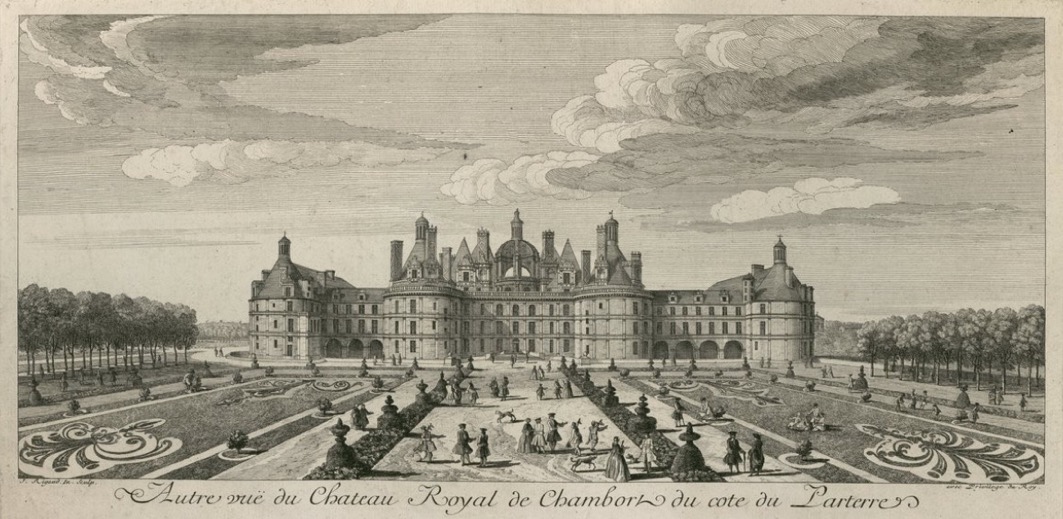
Chambord has been a UNESCO World Heritage Site since 1981, and in 2017 for the first time the number of visitors exceeded 1 million (and nearly 2 million people visited the park). We should remember that Chambord is a world heritage site within the context of the Loire Valley, and as such is just one small bit of a larger protected area (e.g. including the river valley itself and Blois nearby).
My understanding is that a major program of restoration was initiated in 2007 and as far as I could tell is was still on-going when we visited in 2018. During our visit we could see that the roof was still undergoing repair work and walls were being cleaned. In 2014 a report mentioned that "Chambord devrait céder aux sirènes de l'hôtellerie de charme" and more prosaically do something about "les allées poussiéreuses l'été et boueuses l'hiver" and "une enfilade de commerces déplorables". In June 2016 the site was flooded requiring a clean-up effort that lasted into 2017.

The château came back into the hands of the French State in 1930, but it was managed in a "manière désordonnée" until 2005 when it became officially a national monument open to the public. In fact Chambord is directly under the protection of the Presidency of France because it is home to "des chasses présidentielles". In 2016 the château's running costs were €16.8 million and its income was also € 16.8 million, including €11.7 million from visitor tickets and €2.154 million in subsidies. Investment in restoration, etc. was €9.86 million. In 2016 a total of 158 people worked on the site.
I mentioned that in 2017 more than 1 million peopled visited Chambord, but as we walk around the site it is difficult to understand that just a few years ago it was virtually unknown as a tourist attraction. In 2013 Chambord was visited by less than 150,000 people. Tourist attraction sounds like an easy to understand description, but it hides a multitude of different things. You have the most famous monuments in Paris (Eiffel Tower, Notre-Dame, Arc de Triomphe, Sacré-Coeur, Versailles,…), and those outside Paris (Mont-Saint-Michel, Carcassonne, Reims Cathedral, Pont du Gard,…). Then there are the museums of Louvre, Centre Pompidou, Orsay, Invalides, Grévin,…). And you have the official French historic monuments, which excludes the Eiffel Tower and most museums but includes such 'unknowns' in Paris as the Hôtel de Béthune-Sully and the Musée des Plans-Reliefs, as well as the Gallo-Roman site of Sanxay and the statue Vénus de Quinipily. And we should not forgot that Europe's top tourist destination is actually Disneyland Paris with 15 million visitors annually.
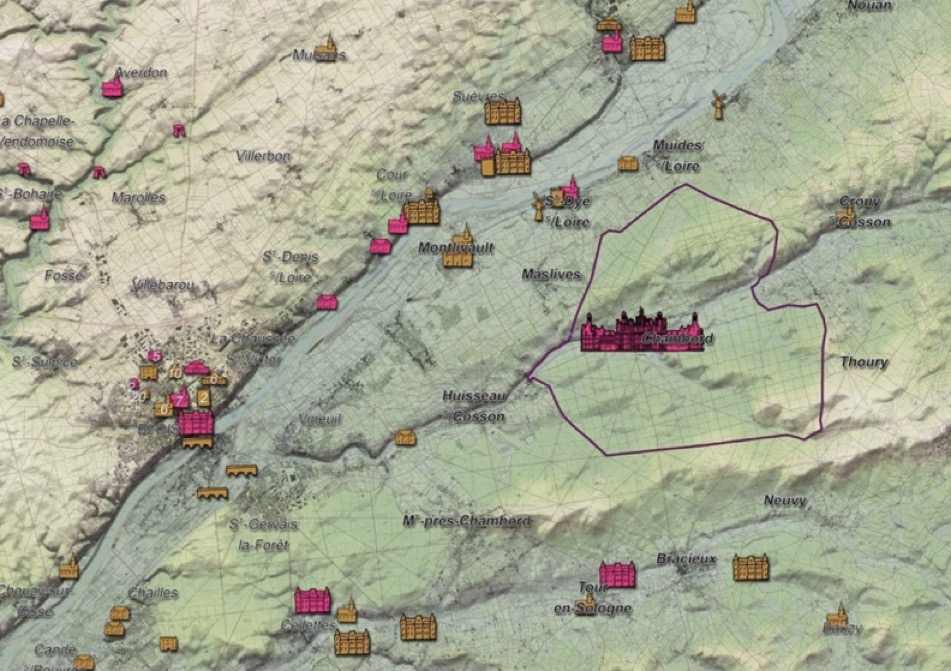
It is worth noting the Chambord is not alone, it is surrounded by both classical and Renaissance châteaux, and well as protected medieval houses, churches, bridges, mills, fortifications, etc., and even a dolmen at Tavers.
A Little Bit of History
Most official texts appear to start in 1230 with a quick mention of a medieval fortress ('château fort') belonging to 'des ducs d'Orléans'. This appears a bit odd since the title Duc d'Orléans was only created in 1344, and was exclusively reserved for the kings eldest brother (they could be mixing up Duc d'Orléans with Comtes d'Orléans). Some reports mention a 10th century 'château fort' belonging to the Comtes de Blois.
Just as a marker, Chambord has been occupied since prehistoric times. The oldest item found on the domain was a biface Acheuléen (probably some kind of blade) dated to about 200,000 years old. Mésolithique (9000 to 6000 BC) arrow heads have been found. Néolithique (7000 to 3000 BC) tools have been found. There are 18 burial mounds ('tumulus') in Chambord, including one necropolis for 6 bodies. Gallo-Roman (100 BC to 300 AD) and Merovingian (AD 450-750) tiles and shards have been found, and there is also a 10 hectare Gallo-Roman site on the Chambord domain. Equally there is evidence of metal working in Gallo-Roman times. The slag usually found at such sites was used in ca. 1820 to restore a number of forest roads, but the slag has been associated with Gallo-Roman shards making it possible to date the development of metallurgy in the region. There appears to have been early fortified settlements in Chambord with defensive ditches, and it is probably that these later became fiefs with the Counts of Blois. In the Chambord domain there is also a man-made pond that predates 1233.
I found a list of 'owners' of Chambord that starts in 830 with a certain Comte Guillaume (Comté was a feudal domain which would 'belong' to a noble Comte). In 860 the name Chambord (or Cambort) was associated with a small farmstead or country house belonging to the Monastery of Corbion (originally founded near Chartres by Saint Lomer of Corbion). By the 12th century the monks occupied the imposing church Saint-Nicolas attached to a vast monastery in the centre of Blois. The origin of the name Cambort probably meant a place situated at a curve of the River Cosson where one could cross on foot. They say that Cambort became Chambort, Chambourt, Chambourd, and finally Chambord.
In 861 the list of owners states that Chambord belonged to the son of the brother of Comte Guillaume, a certain Comte Robert le Fort (ca. 815-866), who it is said became Comte de Paris. Information is limited but there is a Guillaume d'Orléans (beheaded for treason in 866) and a Robert le Fort listed in the Comtes d'Orléans. It is also mentioned that the son of Robert le Fort, Eudes (852-898), was also Comte de Paris and later King of the Francs (888-898). The owners list also states that the second son of Robert le Fort was the owner between 861 and 867, and that this second son became King in 922. In fact Wikipedia lists a Robert (ca. 860-923), brother to Eudes, who was Comte de Paris, Duc des Francs, and who was crowned King of the Francs in 922 (he was killed in 923). The owners list has Hugues le Grand (898-956) as owner of Chambord in 867. Wikipedia tells us that Hugues le Grand was the son of Robert, and father of Hugues Capet (941-996), founder of the Capétienne dynasty. I suspect that by now the farmhouse at Chambord had been transformed into an important medieval fortress.
The next owner on the list is Thibault le Tricheur (ca. 910-977) who had quite a 'varied' career. What is important is that the list indicates that his son Eudes Ier of Blois (ca. 948-995) was owner of Chambord from 978 to 995. Now what we see is that Chambord passed from father to son, with Thibaut II de Blois, Eudes II de Blois, Thibaud III de Blois, Etienne II de Blois, Thibaut IV de Blois, Thibaut V de Blois, Louis de Blois, and Thibaut VI de Blois. Upon the death of Thibaut VI in 1218 Chambord went to his sister Marguerite de Blois (1170-1230).
We see that often a noble in this list is named 'de Blois'. The reality would have been more complex. If we take our friend 'Le Tricheur' (The Trickster) he was Comte de Blois, Vicomte and Comte de Tours, Comte de Chartes et de Châteaudun, Seigneur de Chinon, Saumur et Beaugency, Régent de Bretagne, and Vassal du Roi Lothaire (941-986). In addition, at that time the Comté de Chartres also belonged to the Comtes de Blois. On top of all that he married Luitgardis de Vermandois who also brought with her the Comté de Provins and the Comté of Champagne. If you are interested in history of this family check out the Blois-Champagne here and if you are interested in the concept and history of nobility in France you can check out my separate webpage on the topic.
In 1176 Thibaut V claimed to own about 10,000 hectares of forest including the forest of Chambord. We tend to forget that firewood was indispensable in medieval Europe for both cooking and surviving the cold winters. Coppicing was widely adopted to make faggots which could be easily carried and sold by the cart load. So owning forests meant wealth, but it also meant hunting for wild animals and game, particularly deer. Owners would install a small army of foresters. Capital punishment was practiced for poaching, but fines were an important source of income for forest owners. Of course some forests were public, so the 'common people' could collect firewood and graze livestock. At that time Chambord appears to have been better known for its farming with lots of little hamlets dotted over the domain (most had disappeared by the 16th century). There is reference to wood cutters and 'charbonniers' living in the domain (I think this refers to making charcoal rather than mining coal).
There are signs that a dam of more than 215 metres long and 1.5 metres wide was built to create a body of water on the River Cosson. It is possible that this dates from the 12th century, and it's known to have still existed in 1547, and there are also remains of a mill. There was also a tileworks in the Chambord domain, probably dating for ca. 1300-1350.
We know that the Comtes de Blois owned a château at Montfraut with stables and some houses at Chambord (later Montfraut would find itself inside the grounds of Chambord and in 1403 it was destroyed). Upon the death of Louis de Blois in 1205 (he was also known as Louis de Champagne) his wife retired to Montfraut. We know she resided there because in 1211 she signed texts concerning the status of workers in the city of Blois. We know that Chambord was fortified and guarded in 1393 because there are records of wine being delivered for the guards. It looks as if Chambord remained with the Comtes de Blois until 1397 when Guy II de Blois-Châtillon died. Then all his possessions were ceded to Louis Ier d'Orléans (1372-1407), who was the grandfather of Louis XII (1462-1515) and great-grandfather of François Ier. One text mentions that Chambord was purchased by the Crown in 1498 when Louis d'Orléans became Louis XII (yes he was also a Louis d'Orléans, as was his farther and grandfather). The story goes that François Ier often visited the region as a child. His mother, Louise de Savoie (1476-1531), had a château at Romorantin (only a small ruin remains) and initially François Ier thought to build a new château there. Only later did he abandon the idea in favour of Chambord.
In 1519 François Ier decided to replace the 'feudal manoir' with a château destined for hunting. The model was to be Italian, but it was only finished in 1685 by Louis XIV (1638-1715). By 1524 the old fortress had been demolished and the new foundations completed. Work was interrupted for about 27 months whilst François Ier was held prisoner in Madrid (the ransom was 2 million ecu's of gold or 4 tonnes of gold). The 'donjon' was completed in 1535, and the roof lantern above the double helix staircase is dated 1533. The wing to the north, the north tower and the single storey wing to the north-east were completed between 1535 and 1544, and the 'logis' of the King carries the date 1540. The rest of the single storey wings were stared after 1544. An external spiral stair was added externally for the royal apartments in 1545 and a passage was created also to the terrace of the 'donjon'. Between 1545 and 1547 the ground and first floors of the wing towards the west was built with the tower for the chapel.
Despite it being destined for hunting only about 45% of the domain was forest, the rest were farms. Today the forest represents 86% of the park, but only about 700 hectares (3% of the park) are open to the public.
At the time there was not a central administration in France, and unfortunately most of the documentation concerning the construction of the château has been lost. There are some notary acts, and some bills, etc. concerning the masonry, but thats all.
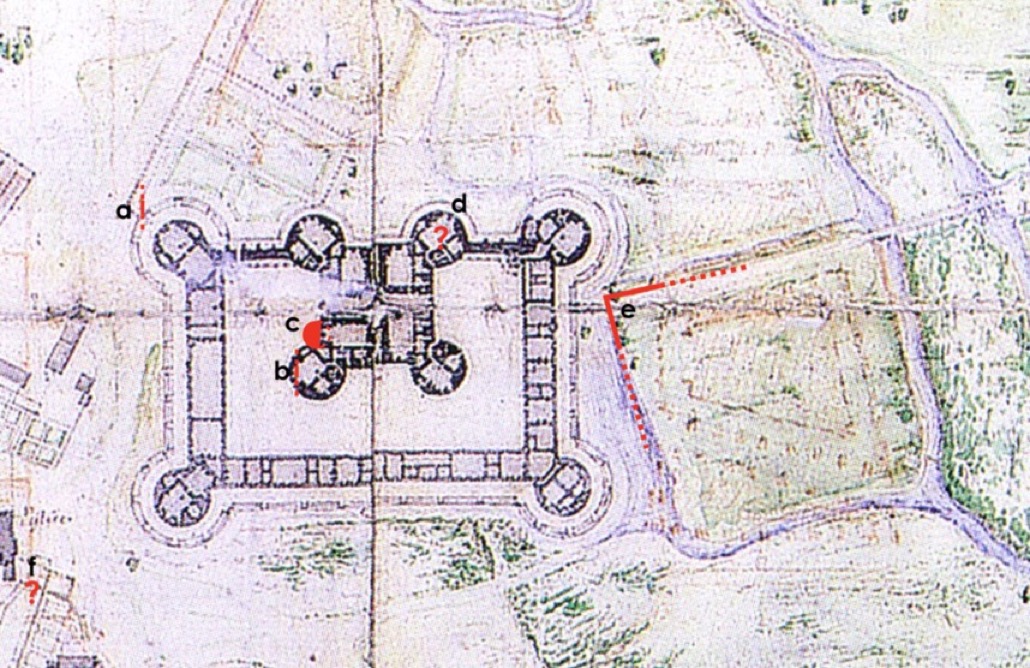
We can see next to the château the remains of the original medieval fortress. Initially it was thought that the original fortress was situated under the present village and chapel (down in the lower left-hand corner). What we can now see is that part of the old fortress is sitting under the "Tour de la Chapelle" (a). The old fortress has also been found under a large latrine pit in the "Tour Henri IV" (b), as an 8 meter diameter solid tower (c), as some masonry that is thought to have hindering the building of the latrine pit in the "Tour François Ier" (d), as a wall uncovered during recreation of the eastern moat in 1972 (e), and finally as some masonry removed by earthworks in the 17th century (f). All proof that the original fortress was actually very large, and that it was not completely demolished as originally thought.
Despite writings to the contrary we do not know who designed the château. Almost every major architect of the period has had their name associated with Chambord. Initially Vignole (1507-1573), then Le Primatice (1504-1570), then Jacques Sourdeau (?-1530), then Pierre Nepveu (dit Trinqueau) who may actually have directed the works until his death in 1538. The name Denis Sourdeau (son of Jacques Sourdeau) was also associated with Chambord until his death in 1534. In 1531 Dominique de Cortone (ca. 1465-1549) received 900 lives for his work on several châteaux including Chambord. Some experts think that Dominique de Cortone is the architect, other prefer the idea that Léonardo da Vinci (1452-1519) was the real architect. This 'legend' is supported by the fact that the King returned from Italy in 1526 with Léonardo da Vinci and a number of other Italian artists and artisans. However no plans or written texts exist to justify such a claim. The sensible approach is to suggest that some of Léonardo's drawing and designs might have inspired the architect of Chambord, whoever he was. We do know that Dominique de Cortone made a large and detailed wooden model of the 'donjon', but that it included a straight staircase and not a spiral one. We also know many of the names of the people who looked after the building of the château (mostly to do with controlling the money), and we also know some of the builders ('maîtres maçons'), and even how much they were paid.
It is thought that when François Ier died, the plans of Chambord were already finished. The 'donjon' was built, as were the two wings, but the 2nd floor and roof of chapel wing were not finished. The single floor wings were under construction. Henri II continued the work, and it was he that had added the 'F' and the salamander to many of the sculptures. But it was Louis XIV who completed and repaired the eight towers, the terraces and the central lantern in 1641-42 (to stop water getting inside the buildings). Between 1683-85 the chapel wing was completed with the chapel roof. At the same time roofing was completed on the single storey wings and a new entrance ('porte royale') created.
There are documents suggesting that the foundations of the château cost 300,000 francs, and that during a 12 year period between 1519 and 1537 more than 1,800 people worked on the site (another report says 1,800 people for 30 years). One estimate put the cost of Chambord as exceeded 5 million francs.
Chambord was built on a vast area of unhealthy marsh. Originally it was thought that the foundations consisted of oak stilts supporting a raft of wood under the stone base of the building. This idea came from a visit in 1550 of the then Venetian ambassador who wrote that the foundations were just like those at home in Venice. However, no one has ever seen the oak stilts. Now experts think the foundations started with layer of fagots of wood and wattle, on which was layered irregular stones held together with a mortar. Then came a bed of yellow mortar consisting of a mix of cement and red sand. One confusion on the use of wooden stilts could have been about the way two walls of wood were used to define and hold together the initial layers of the foundation. Strictly speaking even below the fagots of wood and wattle there were probably sacks made of local reeds filled with clay (a technique known from antiquity). Anyway, on this solid stone and mortar base were placed large horizontal blocks of stone, topped by more irregular stones held together in an irregular and exposed pattern with thick layers of mortar. This represented the top of the medieval foundations, and they were about 4 meters deep at the time. Today the level of the ground is about 150 cm higher than in medieval times. So on top of these medieval foundation we have about 150 cm of smaller regular stones again bedded with thick layers of mortar. Sitting on this we have the initial layers of the wall ('soubassement') made of a limestone ('calcaire lacustre') taken from the northern region of the Loire. This type of limestone is more dense, harder, and limits the capillary effect of the water trying to climb into the upper walls. The main part of the château was built with a local limestone called tuffeau, with a white to yellowish-cream appearance (the same stone used for Chenonceau). Given the enormous qualities needed for Chambord, the tuffeau came from 6 different quarries in the region. Not surprising the foundations cost a fortune.
Henri II (1519-1559) is said to have liked Chambord and in 1556 ordered the completion of the building and the wall around the park (paid for from the wood cut in the park). We know that the architect Pierre Nepveu (dit Trinqueau) was paid 27 sols 6 deniers per day, but we do not have a description of the work performed. In 1547 Henri II had already kicked out all the people living in or near Chambord who did not have a royal concession. This did not make him very popular with the local population. It is also said that Catherine de Médicis (1519-1589) visited often the château. She would stand with her astrologists on the roof and consult the night sky, and they say that she also enjoyed a bit of hunting on the side.
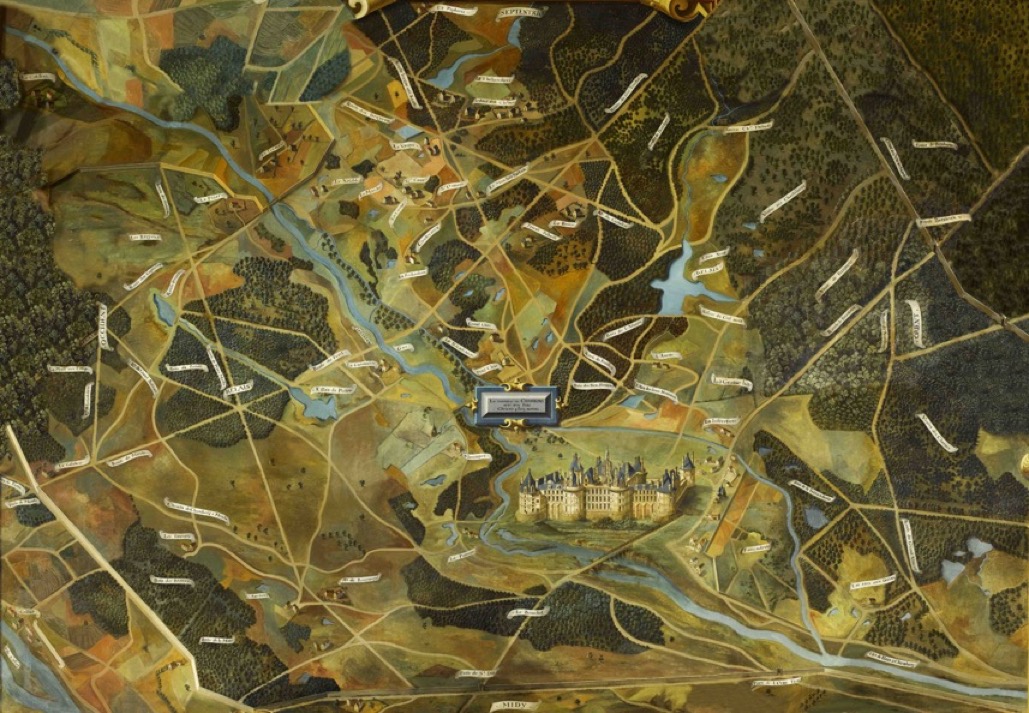
Above we have a plan of the domain dating from ca. 1600, and below we have the detail of the château.

One story goes that Louis XIII (1601-1643) went to Chambord to console himself after Cardinal de Richelieu (1585-1642) had sent home one his 'confidants' Mademoiselle de La Fayette. It is there that he met one of his amours platoniques Mademoiselle de Hautefort (1616-1691) and he also gave the domain of Chambord to his brother Gaston d'Orléans (1608-1660) during the years 1626 to 1660. It was Gaston who completed the wall enclosing the entire park.
In 1660 Louis XIV spent two night in Chambord and ordered some important repair work and a rearrangement of the apartments. He took over the first floor and left others of the royal family to occupy the second floor. The 'saless voûtées' were converted in to a theatre. In 1668 Louis XIV again spent 15 days hunting in the park. In Chambord in 1669 Molière (1622-1673) played for the first time "Monsieur de Pourceaugnac", and in 1670 "Le Bourgeois Gentilhomme" was also played for the first time in Chambord.
It was Louis XIV who built the local village with a small chapel, restored the wall around the park, completed the roofing over the chapel of the château, and also completed the roofing over the one storey wings (he needed somewhere for 'les domestiques'). It was in 1685 that he also had completed the capitals, cornices and steps for the famous main staircase.
Another report noted that it was the architect François Mansart (1598-1666) who was commission by Louis XIV to complete Chambord. Many commented that it was a shame that the façade of the château was masked by the roof he placed on the terrance of the single storey wings. The mansard roof is named after him. The total cost of the work requested by Louis XIV was about 1.25 million livres.
At the time of Louis XIV Chambord consisted of 24 different hamlets (hameaux), but by 1677 this had been reduced to just 5. Later still, in 1759, Chambord village consisted of just 33 houses, 13 belonging to the King and 3 used to lodge the guards.
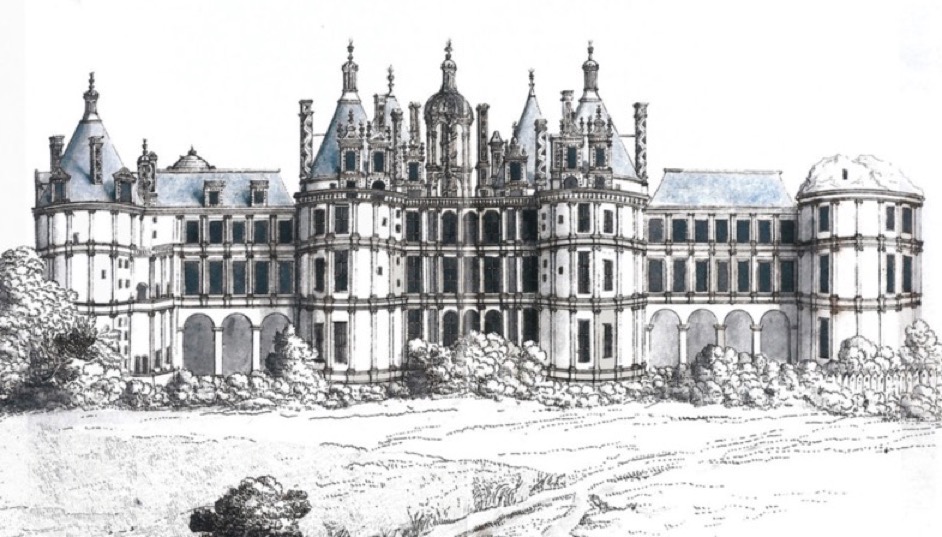
Here we can see an engraving of Chambord, c. 1681. So 134 year later they still had not finished the roof on the chapel.
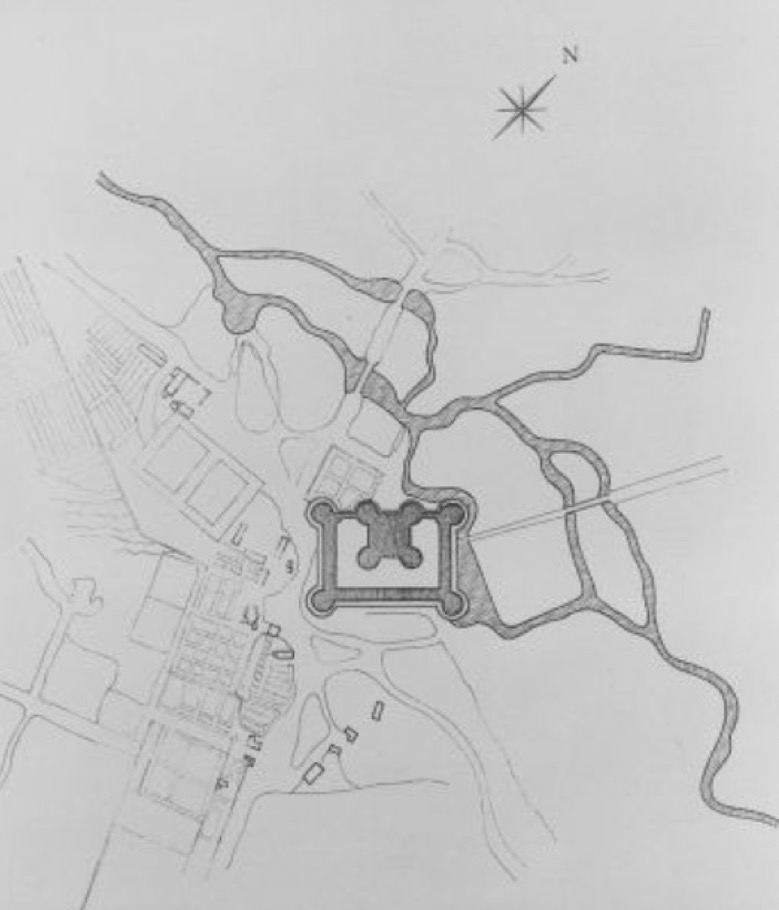
Above we have a plan of the site from 1681 held in the French National Archives. Below we have a plan of the château, its gardens and esplanade (dated 1683-84). No one really knows just how much of these plans were finally executed.
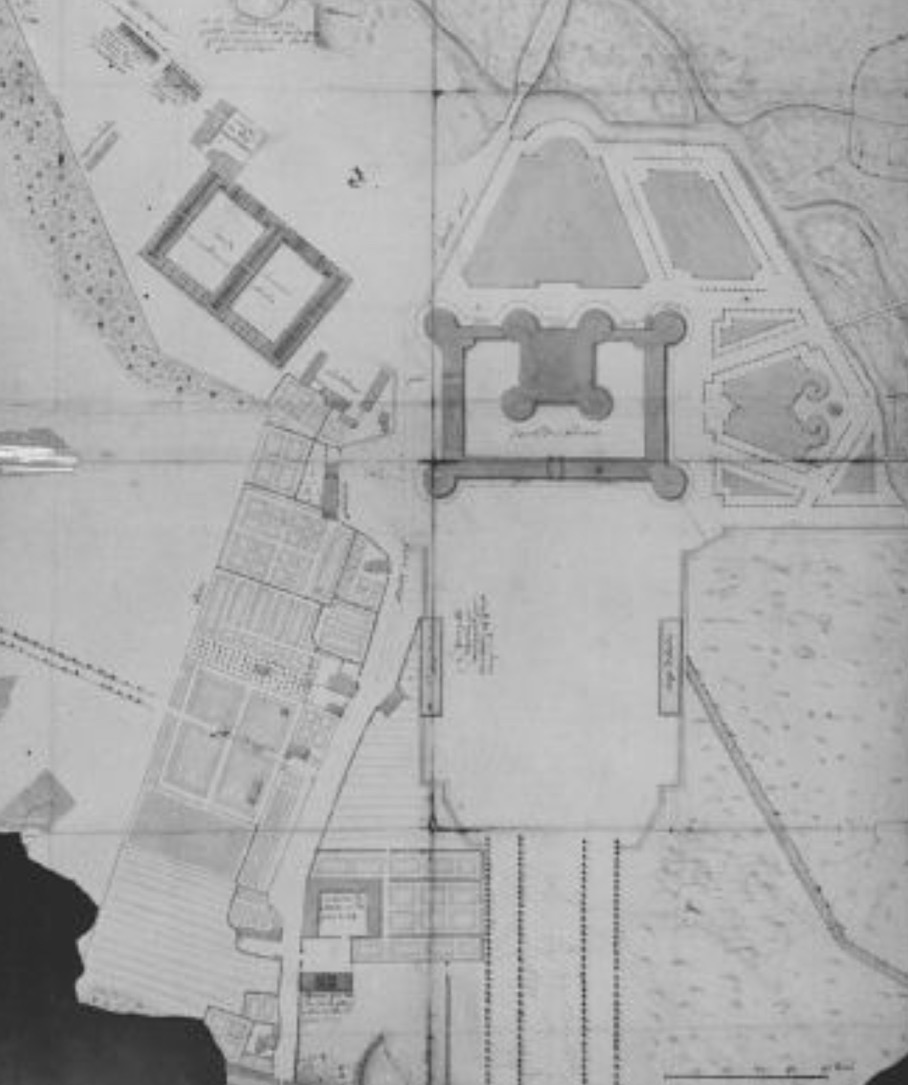
The site was often 'dormant' but was never officially abandoned. In 1725 Stanislas Leszczynski (1677-1766) moved into Chambord (his daughter had just married Louis XV).
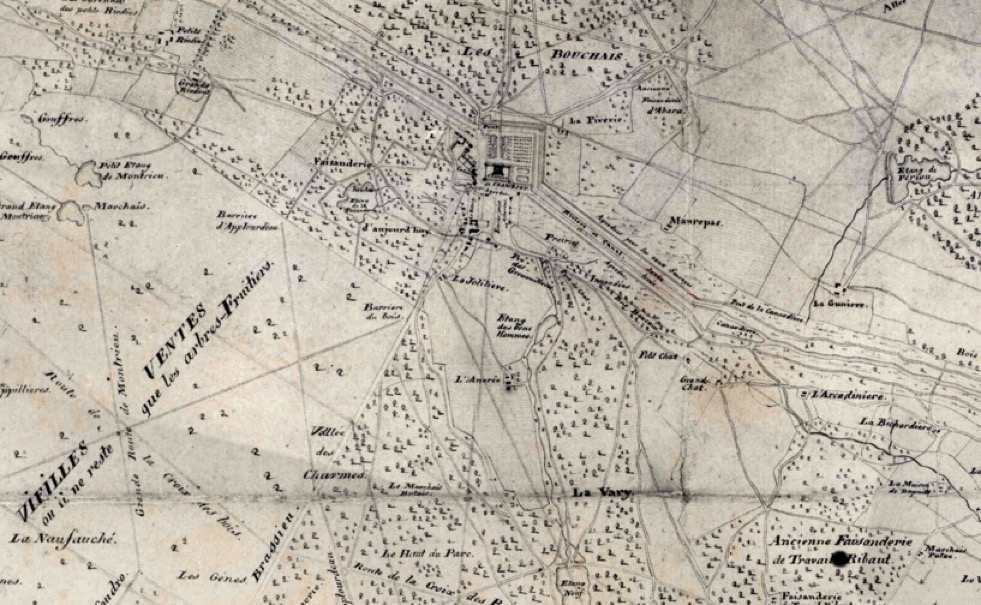
This is a map of the domain prepared for the Maréchal de Saxe in 1745. In the description it is mentioned that the domain covered 10,232 'arpen' (an old French measure of length/area and 1 arpen was equivalent to about 3,000 square meters), and that the wall was 10 feet high and had 7 entrances each with a "pavillon où loge un garde forestier". It also mentioned that the domain had 5,240 'arpens' of wood, 10 arpens of vines, 462 arpens of fields, 2,075 arpens of heather ('bruyères'), 310 arpens uncultivated ('terres en friches'), 80 arpens of lakes, and about 500 arpens for the château, villages, roads, etc. So in 1745 about 50% of the park was forest, but by 1857 this had increased to 85% of forest.
In 1745 Louis XV lent ('don de jouissance') the domain and château to Maréchal de Saxe (1696-1750), who took on a considerable restoration project giving the château back 'ses lettres de noblesse'. Other reports say that he was given Chambord in 1748, and that it was a "véritable cadeau empoisonné". There is quite a story about the death of the Maréchal de Saxe at Chambord. He had a passion for horses and ordered the completion of the royal stables started by the royal architect Jules Hardouin-Mansart (1646-1708). The stables were home to 21 stallions, 199 foals and 128 colts. In addition he housed nearby his regiment with another 400 horses. The story goes that he 'dazzled' the Princess de Conti (who I presume was Marie-Anne-Louise Fontaine) with a display from his regiment. However the story goes on that the Prince de Conti, Louis-François de Bourbon-Conti (1717-1776), was less impressed and he turned up at Chambord with his sword and killed the Maréchal de Saxe. Wikipedia tells us that it is more likely that he died of a poorly treated cold caught during hunting on the estate.
According to Wikipedia upon the death of the Maréchal de Saxe, Chambord passed to his nephew. Wikipedia mentions him as the Comte de Frise, but Charles-Edzard de Frise orientale was the last prince of Frise and he died in 1734. Wikipedia goes on to say that 5 years later he sold it back to Louis XV. Another source mentions a Comte de Friesen (1726-1755) who was nephew to Frédéric Auguste II (1696-1763) - remembering that the Maréchal de Saxe was one of many illegitimate sons of Frédéric Auguste Ier (1670-1733) and thus was the illegitimate half-brother of Frédéric Auguste II. Which I think would also make the Maréchal de Saxe the uncle to this Comte de Friesen. Anyway the story goes that by 1746 the Comte de Friesen was under the orders of Maréchal de Saxe, and after the Battle of Raucoux (1746) Louis XV (1710-1774) named him 'Maréchal de camp'. When the Maréchal de Saxe died in 1750 he asked the King to give to his nephew both his regiment of cavalry and Chambord. Which I presume to mean that upon the death of this Comte de Friesen Chambord was returned to the King.
In the following years Chambord was 'lent' to a Marquis de Saumery (1777-1781) and then to a François Camille Marquis de Polignac (1781-1789). The family Saumery had held the 'gouvernement' of Chambord for more than 200 years. The Marquis de Polignac explicitly asked the courts to allocate no compensation to the family Saumery for that period. It was in 1781 that the Marquis de Polignac created the 'haras royal' (royal stud). As far as I understand it, they were actually created in the single floor buildings of the château that surrounds the 'cour d'honneur'. There was enough space for 160 horses, with the 'piqueur' and 'palefrenier' on a mezzanine floor and the officers in the mansard. There was a report that said that originally the kitchens had been in that part of the château ('l'aile d'Orléans') and that the roof was still temporary. In 1786 they spent nearly 19,000 livres on roofing, glass for the windows, etc.
Below we have a plan of the domain dated 1787.
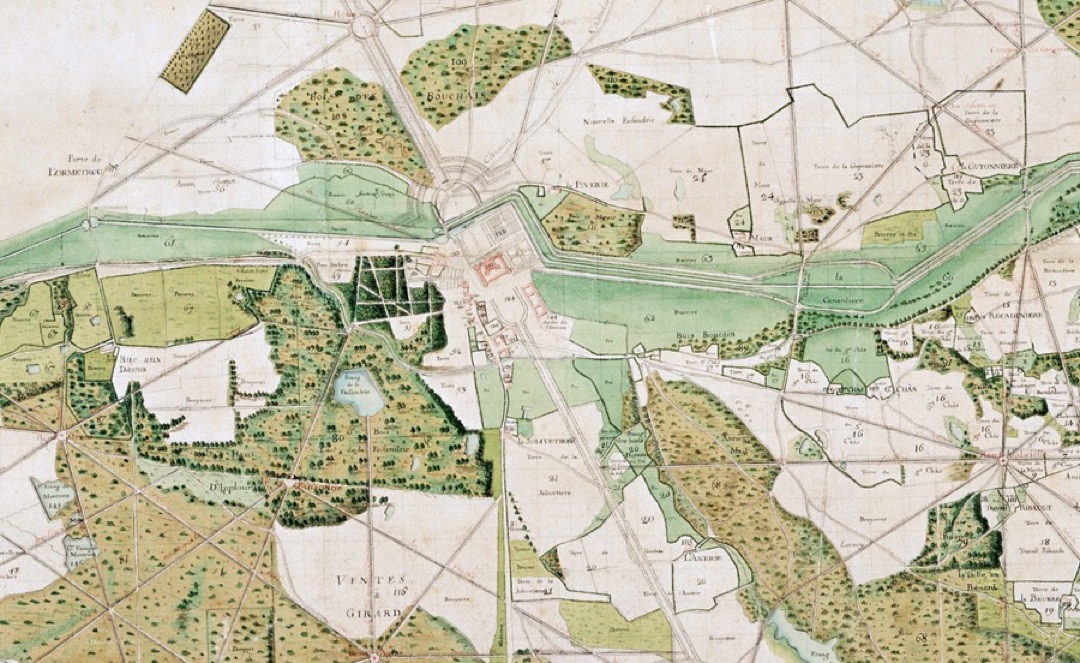
With the French Revolution (1789-1799) the château was emptied and all furnishing with royal symbols were destroyed. One report stated that they tried to sell the château but could not find a buyer. Finally Napoléon bought it and gave it to the Prince de Wagram (1753-1815) in 1809, but it is said that it remained empty until 1814.
As you delve deeper into the various descriptions of the château, there emerge details that sometimes 'muddy the water' more than anything else. I've mentioned twice that Chambord was emptied and abandoned during the French Revolution in 1793. We know that in 1790 the apartments were closed and the furnishing sold for 2,689 livres. The stud was sold in 1792 for 22,388 livres to more than 50 different purchasers. There are documents suggesting that a military unit of 7 'grands officiers', 20 commanders, 30 officers, and 350 horsemen was billeted in Chambord in 1803. During a two year period between 1803 and 1805 they reduced the number of farms from 28 to 20, remove buildings that had been put up during the revolution, and stopped locals from pillaging the park by repairing the wall. And they employed Russian prisoners to clear the local rivers and canals. By 1807 the attitude towards Chambord had changed and the powers of the day were all for conserving monuments such as Chambord. In fact in 1806 it had been decided to convert the 'donjon' to a school for 100 girls, with an investment of 100,000 to 120,000 francs. By 1808 the cost was estimated at 265,000 francs, but in fact the school was never created. Some texts simply suggest that the château was abandoned from 1789 until it was gifted to Bertier in around 1809. In fact Napoléon (1769-1821) finally gave Chambord to Bertier, Prince de Wagram (1753-1815) along with a pension worth 600,000 francs in the form of a 15 year exclusivity on the navigation along the Rhine. It is said that Bertier did visit Chambord in 1810 where he sold some mature trees and then, it is said, abandoned the château. However in his personal papers there are references in the period 1811-1815 to him complaining about neighbours encroaching on Chambord's parkland. There are also notes concerning the work performed at Chambord in the years 1811-1814, including repairs to the walls. Accounts (revenue and expenditure) are available for 1810-1815 showing that until his death Bertier certainly did not abandon the château, even if he no longer visited the site. After the death of Bertier his widow rented out Chambord to someone called Thorton, an English colonel. The rental lasted 2 years and cost 40,000 francs annually. Finally in 1819 the Princess de Wagram obtained the agreement of Louis XVIII (1755-1824) to sell Chambord, which was in a 'piteux état' (I understand when Bertier died Louis XVIII suppressed his pension). The local community protested that there was a risk that Chambord would become a 'lotissement', or subdivided into lots. But finally in 1821 Chambord was bought with a 'souscription nationale' of 1,542,000 francs in favour of the Duke of Bordeaux. The 'souscription' was proposed by Adrien de Calonne, and the money was collected from all the communes in France. Opinions differ, some considering the idea of de Calonne 'déplorable', other rejoiced.
Even this description is far from the reality. The gift of Chambord specifically provided for the return of the property to the French State if it was not legated to a legitimate or adoptive male heir (in many ways Chambord was a royal fief). It was Madame the Princess of Wagram, on behalf of her 5 year-old son, who asked permission of Louis XVIII to sell Chambord. Louis XVIII agreed that it should be sold at auction, and that the French State would exercise its right of purchase, placing the same sum aside for the young Prince of Wagram. In 1818 Chambord became again a State asset, and in 1821 it became the private property of the Duke of Bordeaux when he paid into the French State coffers the equivalent sum (collected as a 'souscription') to that held on behalf of the Prince of Wagram. But that was not the end of the story. In 1830 Charles X (1757-1836) was told that Chambord should not have been sold because it was being held according to an 'apanage', or a provision made for the maintenance of the younger children of Kings and Princes. And as such it could not be sold without the agreement of the 'chambres législatives'. The courts begged to differ. Below we can see what the official 'tourist text' mentions, but if the reader is passionate about knowing the true story they can check it out in the French Journal du Palais for 3 Feb. 1841, which includes the collection of judgements from the different French courts. The net result was that it was only in 1841 that the courts finally found in favour of the Duke of Bordeaux. With the death of his uncle in 1844 the Duke became the senior claimant to the French throne. And Chambord was the only significant piece of personal property that he was allowed to retain upon his exile.
Officially by 1821 the domain was the property of the Duke of Bordeaux, otherwise known as Henri, Count of Chambord (1820-1883). When Henri went into exile in 1830 château Chambord was abandoned. In 1883 the château was left to the Prince of Parme, namely Robert (1848-1907), who undertook a major restoration project in the years 1891-1892. Reports say that it was when the park was re-wooded, the village inside the walls was 'reorganised', and a 'jardin anglais' was created.
The official story is often shortened to the point of being totally incorrect. The idea that Chambord was 'abandoned' between 1830 and 1883 is false, unoccupied would be a better description. For example the site manager, a Mr. Bourcier, managed a major series of restoration projects. The village houses were refurbished, and a maintenance program started for the château. Firstly it was classified as a historical monument in 1840, and in 1849 it was planned to restore the attic of the Princes' wing and the Princes' Tower, which had been badly damaged (the part on the left). We can see below that there were garrets above the single storey wings. Finally it was decided to demolish the entablature and the top of the pilasters and use the materials in a reconstruction of the wing 'Dauphine' nearer the chapel. They were then able to cover the remaining part of the wing with a flat zinc roof terrace. There are some early reports suggesting that in the original construction these single storey wings actually had flat roof terraces.

In 1914 Chambord was sequestered when Elie de Bourbon-Parme (1880-1959) decided to fight for Austria and against the French. After a long legal battle the château and the park of 5,433 hectares again became the property of the French State in 1930. During WW II Chambord was home to the collection of the Louvre.
Below we have the domain in 1913. You can see that the area has been divided up into regular blocks, but we will look at the small encircled numbers (not the large ones) which list features of the domain. So 1 is the Fontaine Caroline, 2 something called 'Les Bouchers', 3 'Le Camp', 12 the Chapelle de Maurepas, 27 the 'ancients casernes', 28 Château de Chambord, etc. The total area of the domain of 5417.05 hectares is divided into 12.56 hectares for the château, gardens, place d'Armes, etc., 26 hectares for the 'pavillions des gardes', 6.50 hectares for village houses, 633.45 hectares for farmers, 4,584.55 hectares of woods, 5.64 hectares for the 'Etang de Montpercher', and the rest making up roads, paths, rivers, etc.
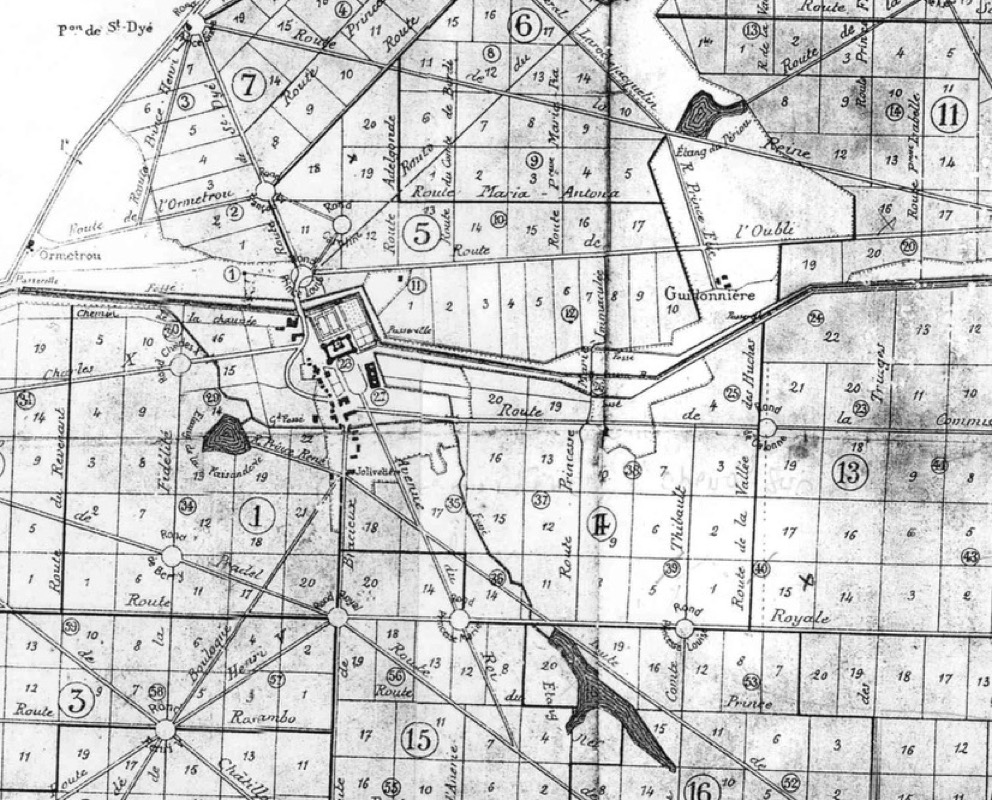
Again what is written is correct, but the story is certainly far more complex. It is true that in 1910 Elie inherited both Chambord and half of his father fortune estimated at 5 million francs-or (today about €82 million). In fact his assets were sequestered when he joined the Austro-Hungarian army. In 1919 with the Treaty of Saint-Germain-en-Laye they started to liquidate those assets. It was at that moment that his sister and brother contested the original inheritance claiming that it had been too favourable to Elie. It took 12 years for the 'Cour de Cassation' to confirm the original decision. Only then could the French State preempt the purchase of the domain of Chambord. A preempt where the French States pays an indemnity that they alone decide. They paid to Elie 11 million francs-or, when in fact experts suggested that they should have paid around 30 million francs-or.
Already in the 1930's the roof terrace of the 'donjon' was repaired, and the remaining 17th C mansards ('garrets') on the single storey wings were removed and replaced by a flat roof terrace. Here we have what were the first attempts to not only repair and restore, but to try to re-capture the original appearance of the château (and remove any later additions).
The château was originally classed as a historical monument in 1840, and the park was added in 1923. The entire site was re-classed as a historical monument in 1997 and again in 1999 (including the wall, the village, the remains of Montfrault, the stables, etc.). Today the site is so well protected that special permission is needed to build anything within 500 meters of the exterior walls.
Our visit starts - arriving in Chambord
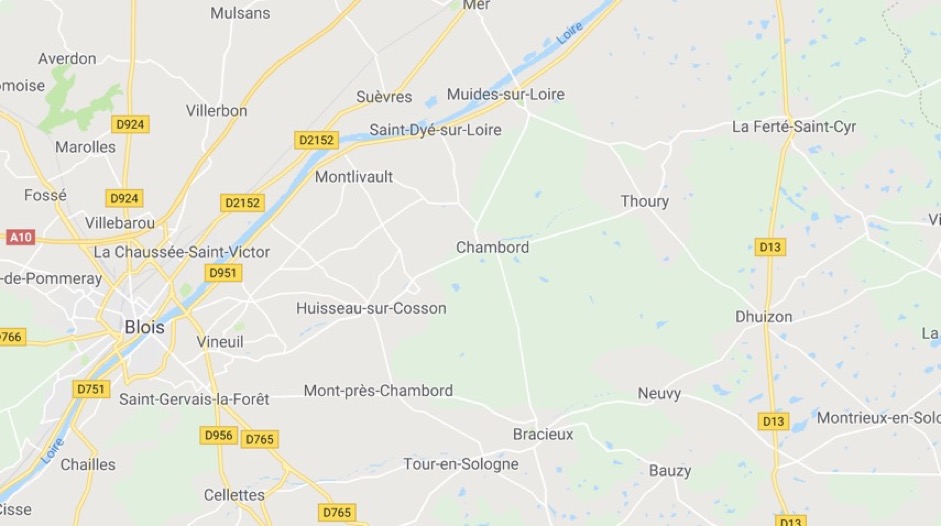
My car GPS wanted us to cross the River Loire on the D174 from Blois but due to a deviation because of roadworks on the D951 we were obliged to return to the north bank and drive along the D2152 to cross the river in the direction of Muides-sur-Loire. From there we entered the domain of Chambord on the D112.
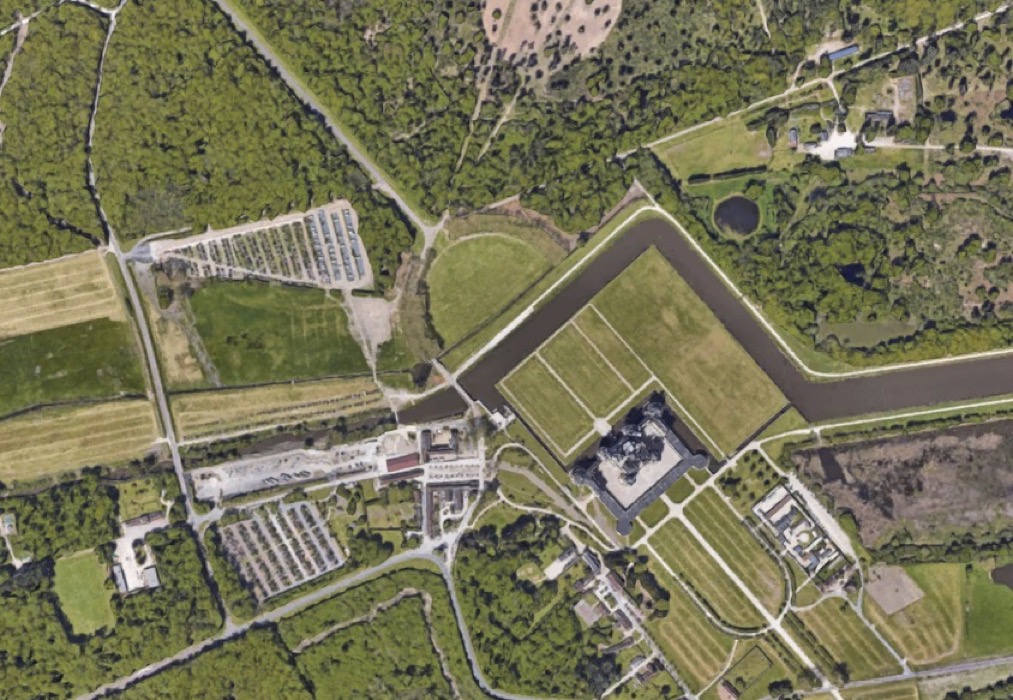
Above we have a better view of the site. Entering the site on the D112 we arrived on the road coming down from the top of the photograph, passing the first parking on the left. Turning left toward the château we passed a second parking on the right, arriving at the private parking of our hotel, the Relais de Chambord (just next to the site entrance and visitor centre with the red roof). Below we have the view of the château from the hotel restaurant terrace.
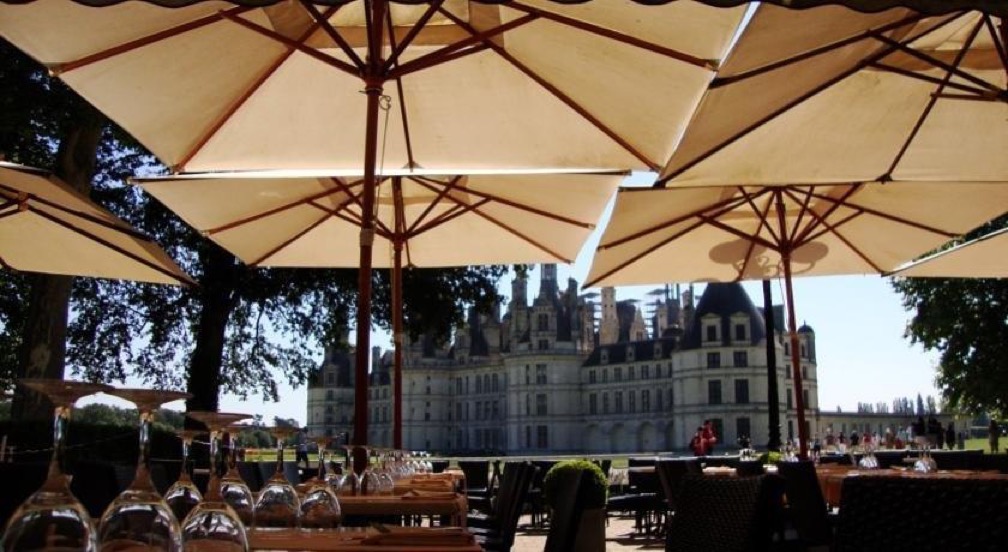
Chambord - universal symbol of the Renaissance
Chambord's unusual and spectacular architecture and its double helix staircase are seen today as symbols of the Renaissance. Visiting the château today we tend to forget that upon the death of François 1er in 1547 it was left empty, and during the French Revolution it was completely emptied. For example in 1830 the château belonged to Henri de Bourbon (1820-1883) who went to lived in exile. Reports suggest that the architecture was the only reason to justify a visit, although in 1846 there was an attempt to create a collection of works in an area of the château where the wood panelling was still intact. Before that there are records of the château being open to the public. Porters were instructed to always accompany visitors and stop them writing on the walls or carving on the woodwork. Entry was free, but visitors were not allowed in with their animals and pets.
By 1850 some restoration work had been done, however reports suggest that there was not much left in the château to restore. In 1852 instructions were given to hang all the paintings together, and "ceux qui ne sont pas bien dans les endroits les moins apparents" (those that are not that good in less obvious places).
Henry James (1843-1916) visited Chambord (see "A Little Tour in France") and noted that you entered through a small door and were shown two or three furnished room with portraits of the Bourbons, a couple of tapestries and some old toys.
An inventory in 1883 listed 60 'objets d'art', 45 paintings, 22 pieces of furniture, and '100's of bits of tapestries'. Most of these pieces were purchased in sales or from art dealers. Another inventory suggest that most of the paintings were of family members, and were purchased in order to show the greatness and heritage of the owners (e.g. François Ier, Henri II, Henri III, Louis XIII, Louis XIV, Louis XV, Louis XVI, Charles X, etc.).
Below we have three postcards from sometime between 1900-1910.



Lets start our visit
We had pre-booked and printed tickets, so we just had to walk around to the front entrance ('porte royale').
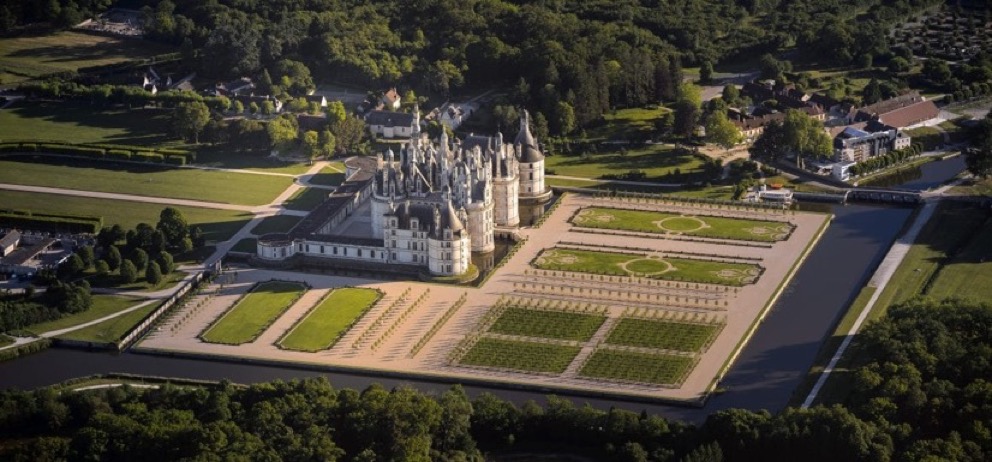
Above we can see in the top right hand corner (west) our hotel next to the main entrance (building with the red tiled roof). The entrance to the château is at the front in the single storey building on the left. If we look to the far left (direction south-east) we can just see where Maréchal de Saxe install his stables. Over towards the south (top left in the picture) we can see what is left of the local village of Chambord, with its chapel. Still today this is legally defined as a village, and is the only one entirely owned by the French State.
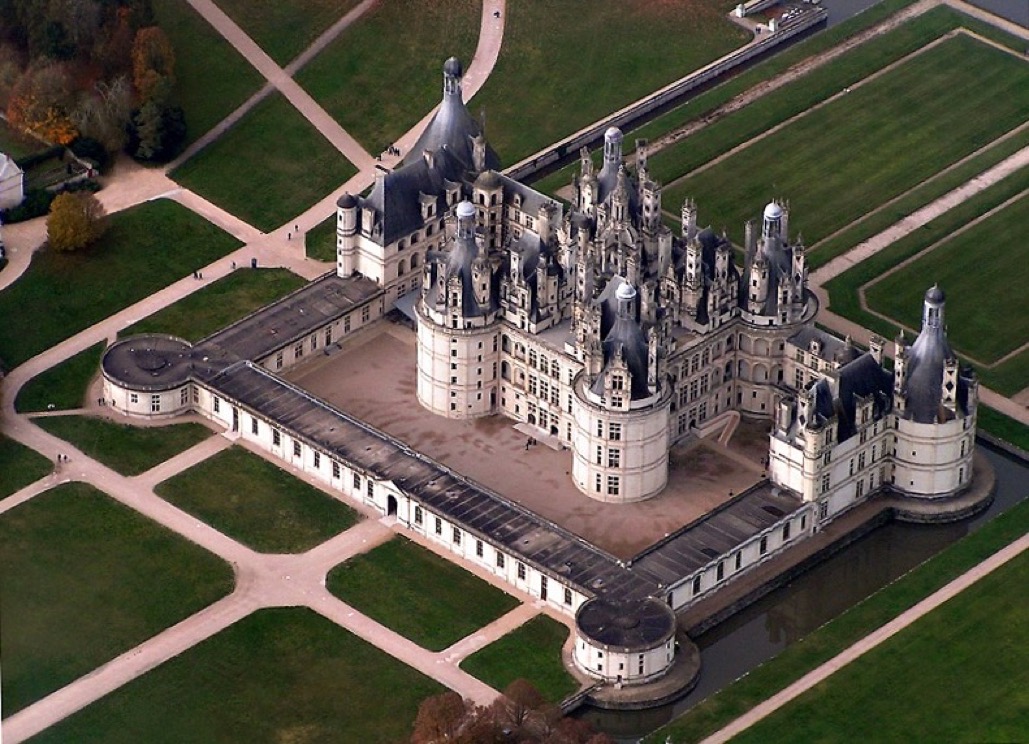
These aerial views give us a chance to present the general layout of the château. We can just see the simple entrance ('porte royale') situated in front of what had been called the 'place d'armes' (an assembly point for soldiers). My understanding is that initially the 'place d'armes' would have been in front of the back entrance to the château. Then with the moat and the building of the single storey wings the main entrance was moved to the south-west side. The enclosed courtyard became a 'cour d'honneur' and the 'place d'armes' was moved to the west. It is on this site that Maréchal de Saxe built his stables. There are some solid indications that the original building with its one storey wings was initially surrounded by a 5 meter wide 'faussebraye'.
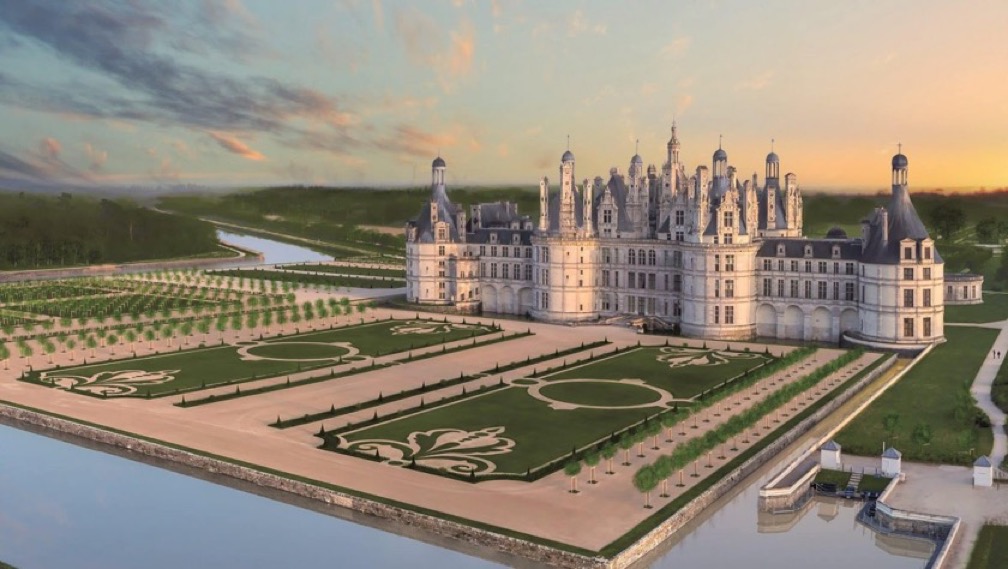
The main part of the château is the massive central quadrangular building 44 meters along one side and with 20 meter diameter round towers on each corner.

On the roof of the central building is a promenade terrance 23 meter above ground level. As you can see in the above model you can walk around the entire perimeter of the roof terrace. The highest point is 52 meters (or 54 or 56 meters) above ground level and is the roof lantern of the central stairwell. It is said that this central building was built first, and that François Ier called it a 'donjon' when he decided to integrate it within a much large building. We often think of 'donjon' as meaning dungeon (an underground cell for prisoners), but originally it was a fortified tower of an early medieval castle or 'keep'. It is interesting to ask if the overall form of the 'donjon' was inspired by a type of pillar where the four faces are reinforced by four colons ('pilier cantonné').


Above we can see a detailed plan of the ground floor of the 'donjon'. We can see the central staircase and the apartments in each corner. Over the three floors of the 'donjon' there were a number of apartments, used for family members, guests and their domestics. All the apartments had chimneys (see below), and many had toilettes.
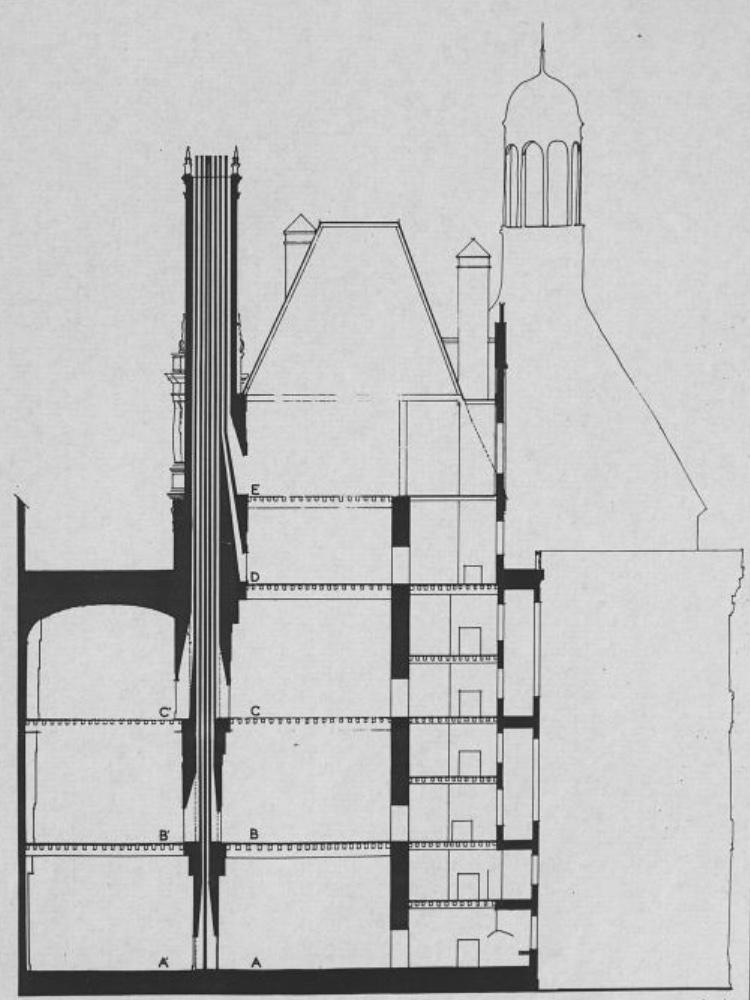
The left front tower (south tower) is called "Tour des Cloches du Henri V". Henri V (1820-1883) was the disputed King of France (from 2 to 9 August 1830), but was never officially proclaimed as such. After the 9 August he became the official legitimist pretender. As far as I understand it, Louis XIV (1638-1715) asked that a wall clock be installed in the château. The dial (clock face) was installed in a 2nd floor window in this south tower, which then took the name "Tour des Cloches". The movement was placed in the roof of the tower. Today the movement and clock frame in sculptured wood date from the 17th century, whereas the clock face and hands are from the 19th century. The clock and the movement are now in the 'salle des carrosses' along with the coaches of Henri V (this part of the château was closed during our visit). I have not found any reference to justify why the tower is now named "du Henri V", except of course that he once owned the château. I have also seen references to this tower a "Tour du Henri IV" as well.
The right front tower (east tower) on the 'donjon' is called "Tour Caroline de Berry", which I guess refers to the mother of Henri V, Marie-Caroline de Bourbon-Sicile, Duchesse de Berry (1798-1870).
The left back tower (west tower) is called the "Tour Dieudonné Cte. De Chambord" (it is usually just known as "Tour Dieudonné"). My understanding is that 'Dieudonné' means ('God given') and refers to the fact that the House of Bourbon was on the verge of extinction until the birth of Henri V. The Bourbon royalists called him "the miracle child" and gave him the name 'Dieudonné' (a subtle reference to Louis XIV who was also born Louis-Dieudonné). In 2013 the tower was damaged in a fire, and just to make things that little bit more difficult the moat was dry so they had to pump the water from a pond 900 meters away.
The right back tower (north tower) is called the "Tour François 1er", presumably because it provided access to his private apartments in the 'east' wing. In addition numerous floor plans indicate that this tower housed the apartments of the Queen.
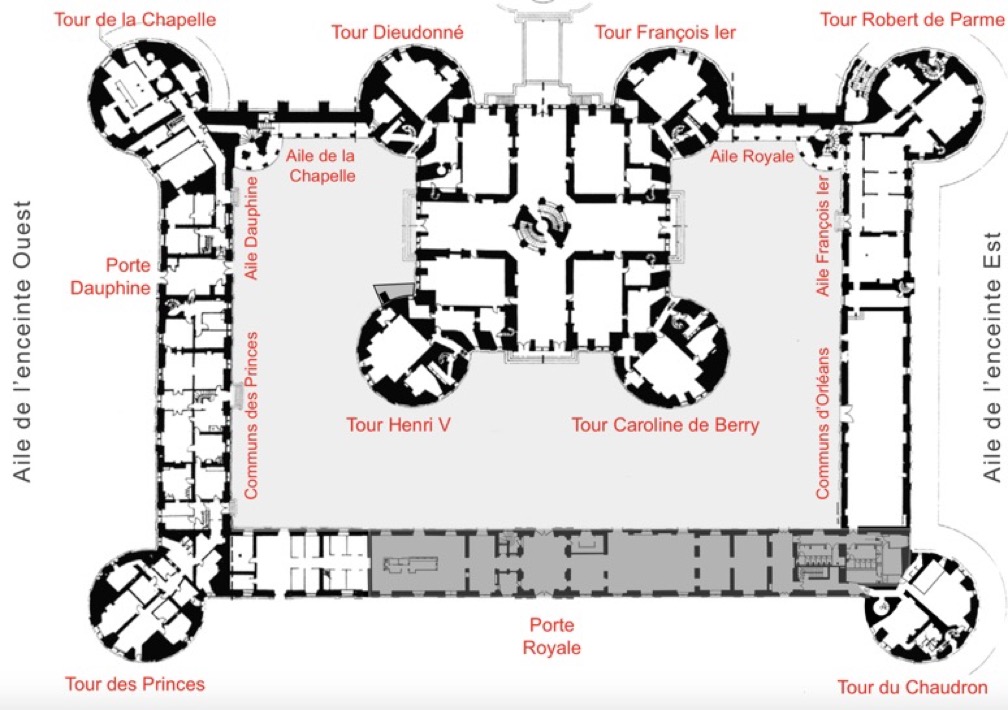
The sense north-south runs from the "Tour des Princes" in the south to the "Tour Robert de Parme" in the north. This would make the different towers simply north-south-east-west. However given that the orientation is not perfect north-south, some descriptions prefer to call the walls north-south-east-west, and the corner towers south-east, north-west, etc. The advantage of this is that the 'donjon' is simply facing north-south. Here I use the simpler way, calling the towers by the cardinal points north-south-east-west.
The larger building was started by integrating the south-west side of the 'donjon' within a building 135 meter long, and finished with less decorative round 'pepper pot' towers inspired by those on the central building (some reports mention the larger building being 156 meters by 117 meters, others 135 meters by 85 meters). Attached to the northern tower we have the apartments of the King ('logis royal' in the 'aile Royale'), and attached to the western tower we have the chapel (with the 'gallerie de l'aile de la Chapelle' as access). François Ier had quickly decided that the 'donjon' was 'impropre' to live in, leaving everyone in a kind of quandary as to what it was to be used for. In fact over the centuries different 'owners' have tried to use it as guest apartments or even as a theatre.
Below we can see the château from the north side, and we can see that the two wings are finished, but that the one storey wings that create an entrance courtyard ('esplanade') have not yet been built (they would be at the back of this view). What we see is that the north side was considered as the main entrance (today we enter the château from the south). I guess this was until they built the moat. It is interesting to note that some engravings, even quite recent ones, show the moat closing off the north entrance to the château. Yet today we can walk out of the north entrance, cross over the moat and access the restored gardens.
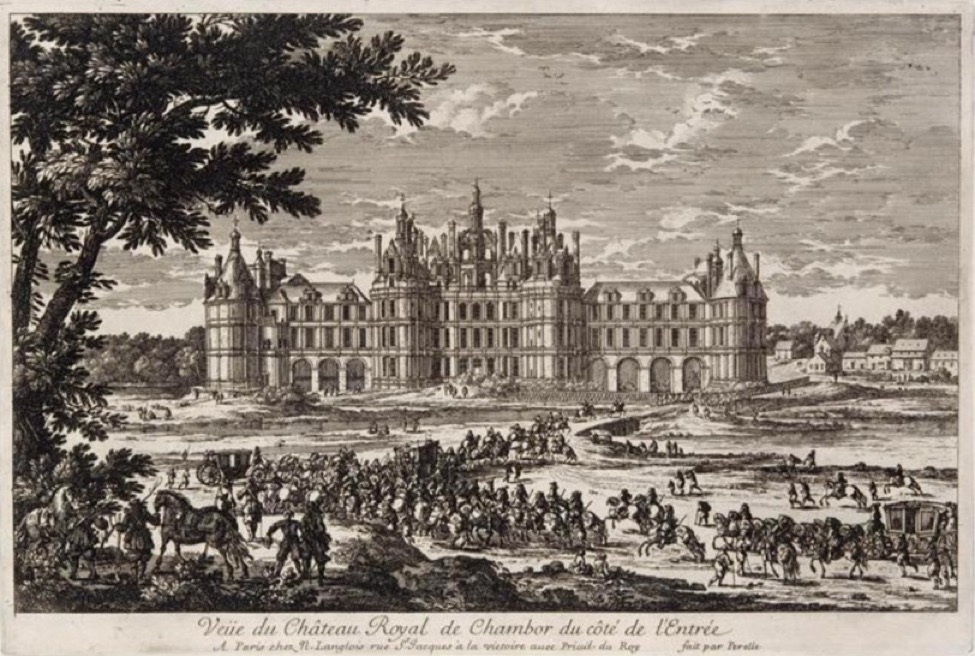
So now the remaining part of the periphery consists of a single storey building, 12 meters wide and with a flat roof terracing. There is a quote from 1576 saying that the one floor buildings were left as such so as to preserve the views from the 'donjon'. It is also said that the two single floor towers in the south-east and south-west corners were the foundations for towers that were never built. Below we can see an engraving from 1576 which actually included the towers that were never built.
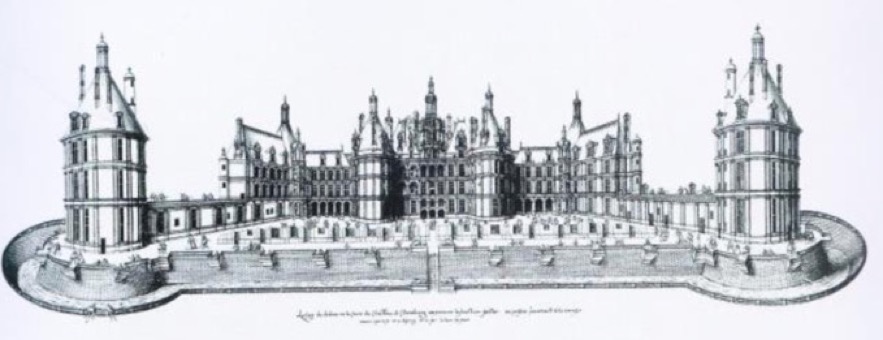
There is some evidence to suggest that the two single storey wings were planned as two storey buildings, but finally left with a single storey in 1556. The front (south-west) face of the courtyard was always planned as a single storey building. There are even plans showing the 'donjon' connected to the 'Porte Royale' by a vaulted gallery (it is probable that this gallery was never actually built).
The front left (south) single floor tower is called "Tour des Princes", whilst the single floor tower on the front right (east) is the "Tour du Chaudron". There is evidence to suggest that the "Tour du Chaudron" was the kitchens in the 16th century. In the 17th century they were transferred to another area along the exterior wall, and around 1750 they were moved again to the west tower of the 'donjon'. There is a small door at the base of the "Tour du Chaudron" which is now used by the cleaning ladies to access the château early in the morning. The two remaining exterior towers are "Tour de la Chapelle" (on the west) and "Tour Robert de Parme" (south). The chapel tower has some stained-glass windows and is topped with a cross. The south tower was only 'recently' dedicated to Robert I (1848-1907) and originally it was part of the royal apartments of François Ier. In fact if one looks at the façade of the château we can see the King's private terrace accessed from his private oratory or private chapel.
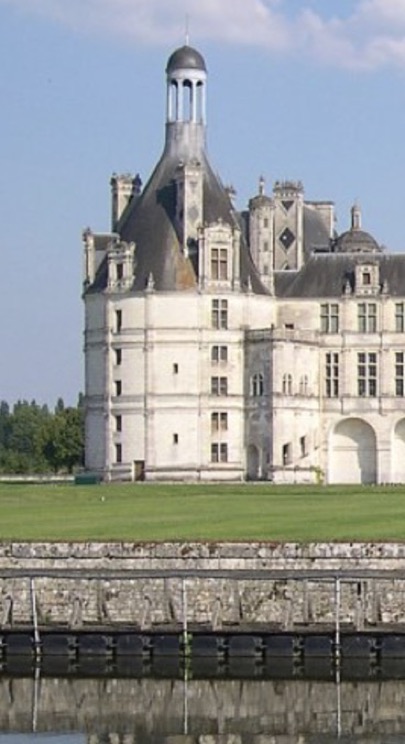
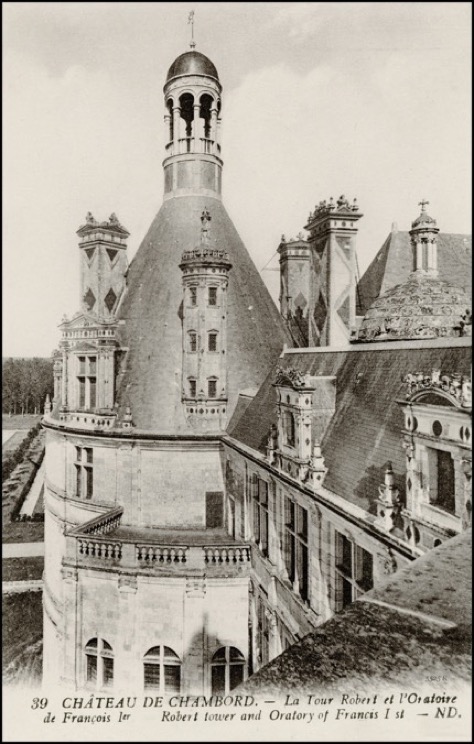
I'm not sure but I think that the below door is for the King's private chapel, and is a pure (and original) Renaissance door. It is said to be one of the few items in the château that are both original and complete. We can see the 'F' and the salamander, emblems of François Ier. In fact the apartments of François Ier were the most complete and most elaborately decorated, and included both connecting corridors and secret stairs not found in the rest of the château.

Experts have noted that in the beginning it would appear that the desire was for a building (the 'donjon') very much open to the nature of the outside parkland, and over time it became very much more closed upon itself. Equally experts tend to think that much of the additional building was designed to harmonise (or even amplify) with the 'donjon' rather than 'fit-in' with the parkland surrounding it.
Capture a moment in time
We are standing in front of the château, but before we enter let's try to capture that moment in time when François Ier would have enjoyed one of his short stays in Chambord. He, more than anyone else, represented that transition from the Middle Ages to more modern times. His Court and his magnificent châteaux would have attracted the more civilised nobles to leave their lands and create a kind of 'luminous aureole' around the King. Living with the King, the nobles would have slowly lost their independence. Being in the 'service' of the King was very rewarding, allowing them to build their own, more modest, châteaux. François Ier had created a completely new class of nobles, offering social promotion based upon merit rather than birthright.
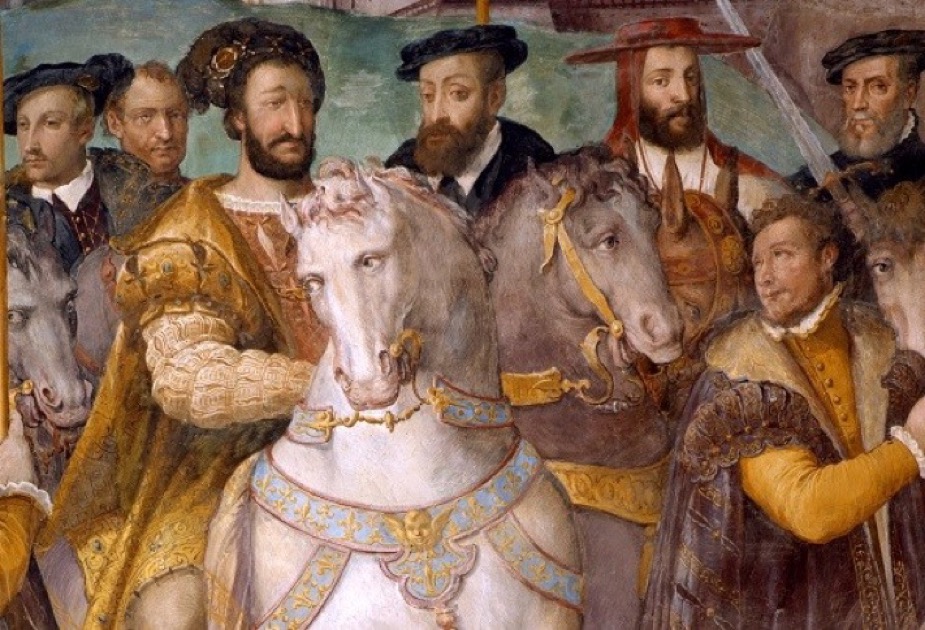
The courtesan had become a respected figure during the Renaissance. She was given an important social position and often not inconsiderable wealth by her network of 'clients'. No longer was the courtesan expected to simply flatter her Prince but now she was expected to shine by her culture, intelligence and emotion.
François Ier started by being the "premier des gentilshommes" as in a medieval Court, but he rapidly evolves in to an absolute monarch. He became 'above' and not 'part of' the Court. Later Kings would refine and impose an even more complex protocol, ruling in every little detail the ceremonial aspects of the Court.
We are in the early 16th century, but by 1576 the royal family was recognised as preeminent in the Court. Etiquette was codified in 1578. This included instructions on washing every morning. Anne de Bretagne (1477-1514) created the 'Maison de la Reine' (the Queen's Household), and the role of 'Dame d'Honneur' was created in 1523. The Court was no longer just a place for noble men, women brought elegance, imposed politeness, and introduced civil society. In 1523 the Court consisted of 540 officers and servants, by the end of the 16th century it had grown to over 1,500 people. Slowly several Courts would appear, the King's, the Queen's, then the Court's of Princes of blood, and even the high ranking officials of the King would have their own Courts. The Courts became to be know as 'Maisons' ('Houses'). Add to that the powerful figures of government, ambassadors, and rich merchants who followed the Court as it moved from one palace to another. Through the 16th century the Maison Royale grew from about 1,000 people to about 10,000 people, and the Court moved increasingly often because in a matter of weeks they would have eaten and drunk one palace dry.
The 'House' of François Ier consisted of three 'departments'. One to look after 'la table royale' and the second to run the religious life of the King. The third was for the bedchamber. This included the ceremonies of waking and going to bed, the wardrobe, the toilette, the Council office, and the Chamberlain (later replaced by the valet).
Then we have those responsible for moving the Court. Carriages and horses, people looking after the money and making payments, people looking after the precious crockery, furniture, tapestries, etc., and naturally all those involved in hunting and falconry. And we should not forget the personal guard of the King, 300 archers, 100 soldiers, and 200 'gentilshommes' (knights).
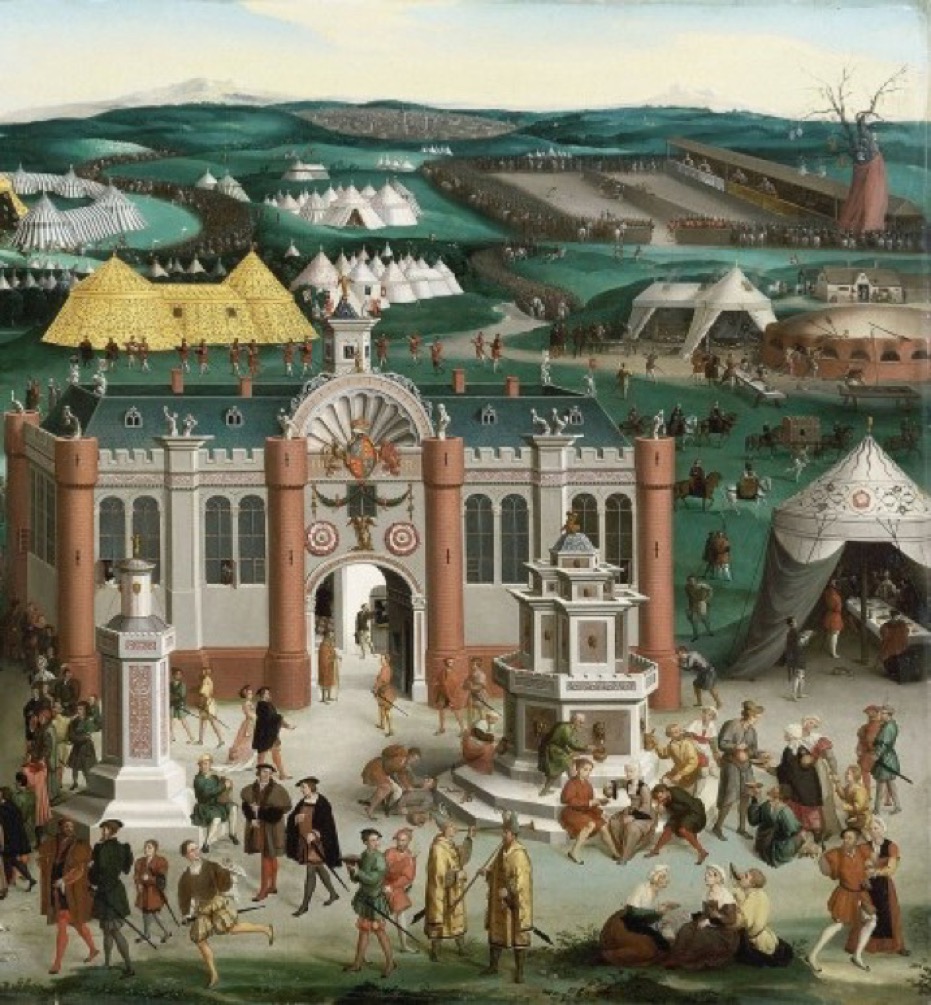
In fact the Royal Court would move around, changing places every 2-3 weeks. One reason was that the King constantly visited monasteries and sanctuaries. Second, moving maintained a link between King and people (bypassing the nobles), and usually his arrival would be a good reason for local festivals, etc. On top of all that he could show off his power by distributing privileges to local gentry. And above all it was a way to collect taxes directly, again not passing through the nobles. The downside was that almost everyone had to rush around finding a place to stay, and it quite often happened that nobles would end up sleeping in tents. Naturally those favoured by the King accumulated great riches, for example the Lord Anne de Montmorency (1493-1567) died owning more than 130 châteaux. And once the King had moved on, the locals had to clean up and prepare for the King's next visit.
Also François Ier increasingly took advice from his 'Conseil des Affaires' rather than his nobles. However, he kept his noble close at hand. They provided opinions from all over the realm, and he could also better detect any conspiracies brewing. François Ier also owned more than 100 different châteaux, but more often than not he would stay with one or other courtesan, or a 'friend' such as Anne de Montmorency. Many nobles would purchase a château known to be on a route well frequented by the King. A visit from the King would cost a fortune, but was an immense privilege. A few even installed special bathroom apartments. It is true that people thought that water opened the pores on the skin and permitted illnesses and diseases to enter. However small bathroom suites were built in many châteaux of the period to be used by a restricted group of nobles and courtesans. The baths would be made of wood, there would be seats covered in lead, and mobile screens were used to separate different bathing areas. There would also be an area for massages and a Turkish bath. Scents and perfumes would be brought from Italy. They might also rinse their teeth with water mixed with wine. Oddly enough, later generations would abandon the hot bath, and bathing would become reserved as a medical treatment.

The wars with Italy opened a period of rich clothing and fantasy ornamentation, e.g. lace, gold thread, and colourful trimmings ('passementerie'). However, everyone was expected to strictly respect their social rank, and dress accordingly. The higher your social rank the more expensive must be your clothes.
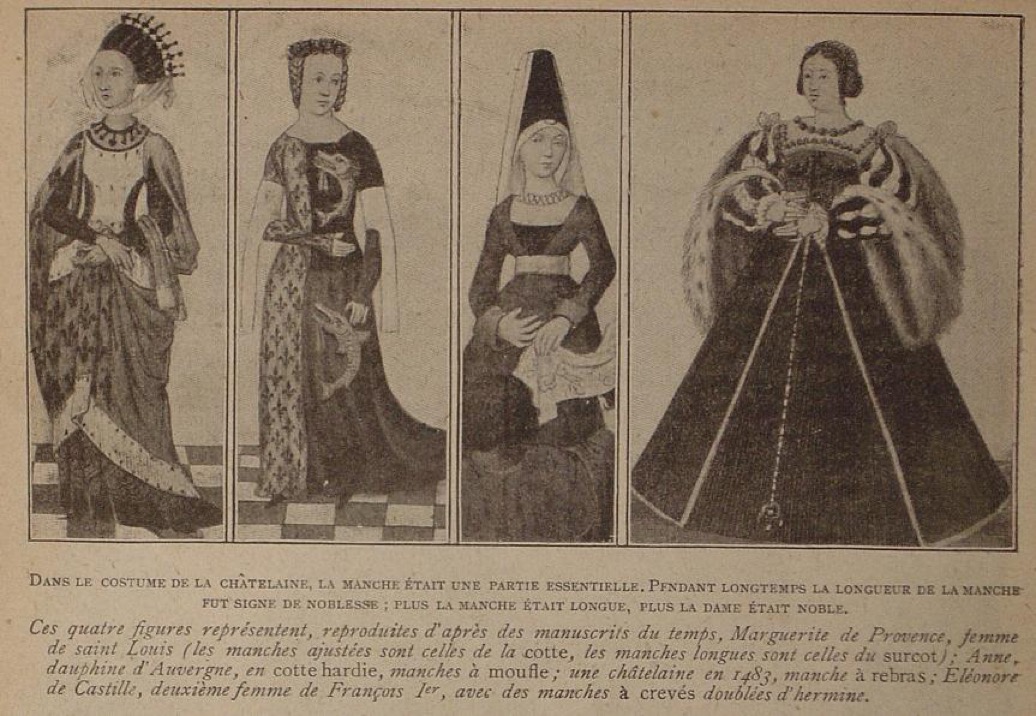
Even in those days, overdoing it was also considered a sin and an offence to honesty and prudence. Over spending was bad for the economy, since the money was going to the 'enemy' Italy. In fact laws were past against 'sumptuous' clothes. François Ier actually stopped 'gentilshommes' from using gold or silver cloth, and later he would ban velour from mens clothing. This did not stop the men using rich cloth and lace, and above all lots of jewellery.

Nobles would typically wear pleated shirts, a doublet with a boat neckline, short or lengthened with a skirt. It would reveal an overflowing fly ('braguette') shaped shell often highly decorated. His legs would be covered with glittering silk tights and a loose and pleated over-vest sometimes descends to the thighs, topped with a belt with a sword and dagger. At the end of the 15th century, shoes appeared almost square, sometimes openwork, nicknamed "bears foot".
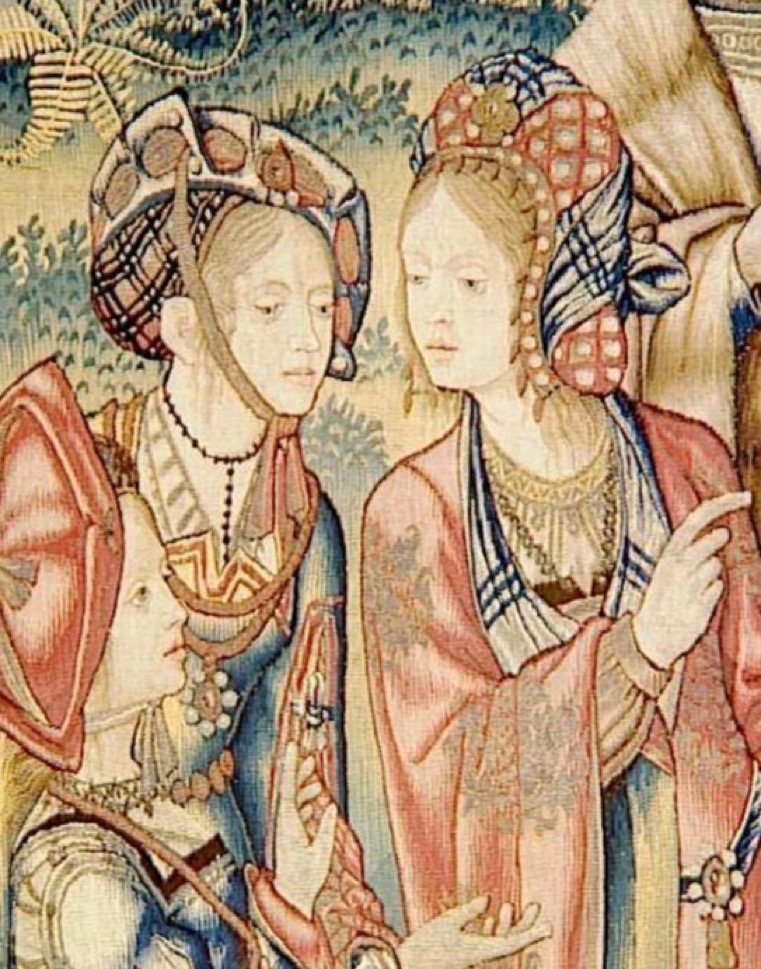
Women would wear at the beginning of the 15th century a large flared dress and an underdress, a very ornate bodice or overcoat (brocade or velvet lined with fur) with a square neckline. The overcoat will become a major garment in formal dress until the 17th century. Over time the sleeves will grow in size. To go out, a lady must cover her head with a veil or a headdress, often worn on the back of the head. Only servants go bareheaded. The forehead would be enhanced by an eyebrow depilation and their hair would sometimes cover the temples or ears by two buns retained in a fishnet (or just one at the back of the head).
Later, under the Spanish influence, women would hide the décolleté (like the men) and they would wear a 'vertugale' or corset. Their silhouette will become stiff as opposed to the fluidity of the early Renaissance.
Now that you are properly clothed and versed in the social etiquette, it's time to sit down for some food. The place given to spices remains important, and light sauces, acid and sweet and sour remain largely in vogue. However, the attraction for sweetness, already present in some medieval kitchens, is on the increase, and throughout Europe, sugar ornamentation reaches an extreme refinement.
In the 16th century new ingredients appear in the kitchen (cocoa, tea, potato, coffee, turkey, spices, cane sugar ...). With the Italians culinary know-how becomes an art and printed cookbooks are very popular. The quality of the food and its abundance is a sign of a dominant social position.
The wine, always cut with water because of its very heavy and thick character, is the common drink. Cider, beer, liqueurs and fruit juices are also appreciated, while milk is rather consumed as a remedy or for its cream. Adults and children alike love rose syrups, almond milk, lemon syrup and orange juice.

Most produce from the recently discovered Americas such as corn, tomato, potato or pumpkin, had still not arrived in the 16th century kitchen, however turkey quickly appeared as an excellent substitute for medieval goose. But at dinner the usual meats were still served: capon, roast chicken, boiled veal, beef, mutton, game, thrushes and partridges, fish with sauces (in vinegar with sugar and cinnamon, or with verjuice). Turkey and tomatoes (new arrivals from the Americas), peas, artichokes, candied fruits in brine or syrup, as well as asparagus coming from Italy would also be on display.
Vegetables for children were peas and chickpeas while adults consumed leeks, onions, pumpkins and salads, as well as strong spices and condiments like mustard or horseradish. The most popular fruits were strawberries, cherries, plums and grapes. They also eat cooked apples and pears, fresh almonds, hazelnuts and walnuts, marzipan, choux pastry, fruit jellies (dried jams), candied flowers (ancestors of violets in sugar), candied fruit peel, nougat and ice cream. The sweets were consumed in the form of fruit pastes, compotes or jams.
As a guest you would probably have sat on a bench with a table made of trestles and a movable board (hence the expressions "dresser" and "raise the table"). On your table there would have been plates, glasses and lots of fruits, but no forks or spoons. A 'French' service is where all the dishes are served at the same time (the many dishes would have ended up full of food waste). At the Court, dishes were presented by the 'esquire'. Nobles would take by hand or with a fork and knife what they wanted, cut everything up on the plate and eat it with their fingers. The fork would remain on the service plate, but knives were personal. In addition, in the absence of a towel, hands were washed at the beginning and end of meals in basins brought by valets. Later some nobles would have their personal forks and knives kept under seal to avoid being poisoned. The sauces and soups were served in soup plates and they would be eaten with bread. In the early 16th century glasses would still be shared, the use of the individual cup (metal or glass of Venice) would gradually defuse through society. However glasses were not placed on the table but on the buffet and filled on request by a butler who would offer it on a plate.
In earlier days meals were a mess of bad table manners and bad behaviour. Only the (re)introduction of courtesy brought the ladies back to the banquets. The introduction of the fork and the napkin became relatively common after François Ier, proving also to be a success with the ladies. In fact the fork first appeared in Venice in the 11th C but only arrived in France at the end of the 14th century, although it took another 100 years for it to move from the serving dish to the tabletop.
Usually the King would eat alone sitting under a canopy, only later would he be separated from the court by a balustrade. The service at the King's table was the subject of a complex ceremony designed to solemnise every action during the daily meal, the key was to perceive the wealth on display.
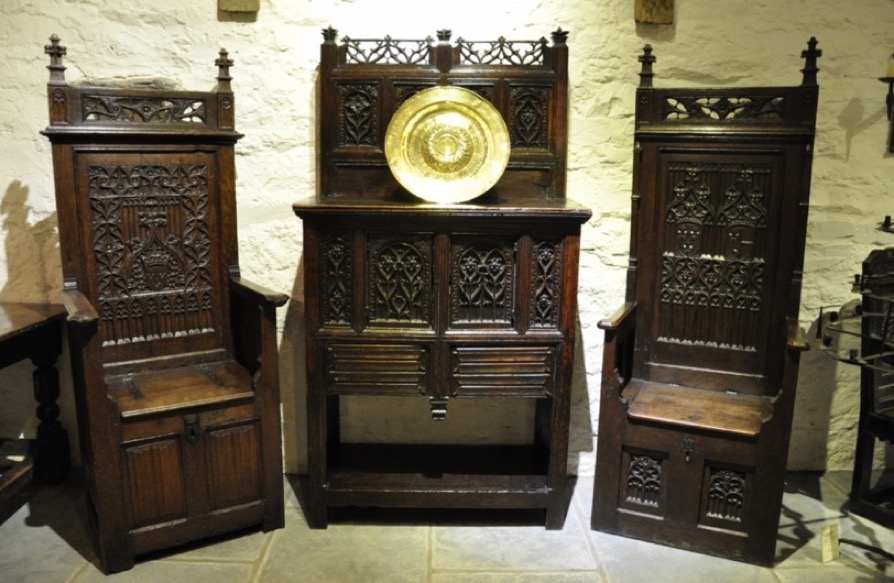
The 'dressoir' or buffet was a key piece of furniture for any self-respecting Prince. In the 13th century the shelves held the things needed for the service at the table. But as these pieces become more and more ostentatious (silver and gold, Italian majolica, Venice glass, tin, etc.), the items gradually lost their original utilitarian function in favour of things almost exclusively decorative. These pieces were intended for show, and not to be used. They would either be elaborately decorated or carry the coat of arms of the owner. It was all about honouring guests and flattering them with the pageantry of the meal reserved for them, whilst making them aware of the opulence, the artistic taste and the wealth of the host.
Now that you are properly dressed and well fed, we can start our visit.
Proceeding into the 'cour d'honneur'
So we are now standing at the 'front' of the château, looking at the south-west wall. We can see the one storey building in front of the 'donjon'. We can see the two one storey towers, and the main entrance. And to the left we can also see the narrow 'Porte des Princes' and to the right the 'Passage du Chaudron'. During our visit we could see that the French Gendarme were installed in the 'Porte des Princes' and we could actually see a couple of horses poking their noses out of the windows on the left side.

Walking though the central 'porte royale' we had our ticket and bags checked, and then moved into the 'cour d'honneur'. This is the château's ceremonial courtyard, which is usually found in front of the main building (the 'corps de logis' in this case is the 'donjon') and flanked by symmetrical secondary wings usually containing minor rooms.

Standing in the 'cour d'honneur' we are faced with the entrance to the 'donjon'. It is interesting to remember that in the very early design of the 'donjon' there were no exterior walls hiding the central double helix staircase. This explains the coffered vaulting ('caisson') on the roof of the 2rd floor of the 'donjon'. We will later study this vaulting, but it was clearly designed to support the roof between the 4 towers without using exterior wall support. In this original design with the open double helix staircase experts see the hand of Léonardo da Vinci (1452-1519). By 1516 Léonardo was in the service of François Ier and lived near the royal Château d'Amboise, around 50 km away. Da Vinci died before the start of Chambord, so what experts see is the hand of Léonardo in the plans and the design of the double helix staircase.
As we have already noted the stone used for the wall was the tuffeau. What we see before us are walls 120 cm thick composed of cut stone blocks of about 30 cm high. Large blocks would have been cut and brought to the site on the local river to the port of Saint-Dyé-sur-Loire, some 5 km away. There is a strong possibility that the blocks would have then be finished on site. The 'cour d'honneur' is still deep with tuffeau chips.
What we see before us is the 'donjon' started in 1519, and there are letters of the period indicating that just the foundations cost 300,000 francs. Between 1524-1526 the work was stopped due to the fact that François 1er was held prisoner for 27 months in Madrid. The roof 'charpente' was made by a certain Maugyn Bonneau and dates from 1534 (it is still in place today).

Over a 12 year period the building cost 5 million francs and employed 1,800 workers. It was in 1537 that the 'donjon' was finished and they started on adding the wings with additional towers, and then they went on to building the single storey wings ('trois corps de logis') and their roof terraces. There is a note dated 1544 ordering the construction of a 'escalier à jour', which could be a reference to the building of the double helix staircase (the building has 77 sets of stairs). In 1556 Henri II (1519-1559) ordered the completion of the building and the construction of a wall around the park. But even in 1566 it was said that a major investment was still necessary to stop Chambord falling into ruin. Despite repairs made in 1641 it was still noted that the 'donjon' roof vaults leaked water. And the repair work was only finally decided upon by Louis XIV in 1681. The problem of leaks in the roof terrace persisted until 1990 and the roof terrace slabs were only removed in 2005.
The stone used was the so-called 'pierre de Bourré', from a small village that supplied a 'pierre de tuffeau' (a type of sandstone) used in numerous châteaux and walls in the region of the Loire. It is very easy to work because it is not very hard, and masons loved it because they knew that their descendants would be back in a couple of hundred years to repair and replace pieces. Chambord used a particular white variety of stone, that unfortunately is also very porous. The stone was actually carried by boat up the Loire and along the River Cosson to a dock near the château. The roofing is 'ardoise bleutée de Touraine' (a blueish slate).
When we see the château today we see it as something very solid and stable, unchangeable. However a study of the 'Tour du Chaudron' shows that the internal structure of the rooms on both the ground-floor and on the mezzanine change 12 times from 1576, and included the creation of perhaps as many as 6 new openings and windows.
Various guidebooks say that the château has between 426 and 440 rooms (and of course exactly 365 bedrooms). It does not really matter for fortunately we can only visit a very small number of them.
The 'donjon'
As we enter the 'donjon' what we have are three floors each in the form of a Greek cross, i.e. a cross with equal length arms. In the centre there is the famous double helix staircase. Set in each corner there are 2 apartments, one in the each corner, and one in each of the four towers. We can see below the arrangement of the rooms on the 2nd floor, ca. 1700. Each apartment would have a bedroom, an oblong 'cabinet' (a kind of small study), and a square wardrobe. Despite the desire for perfect symmetry the overall shape of the 'donjon' meant that different rooms had to be oriented differently.
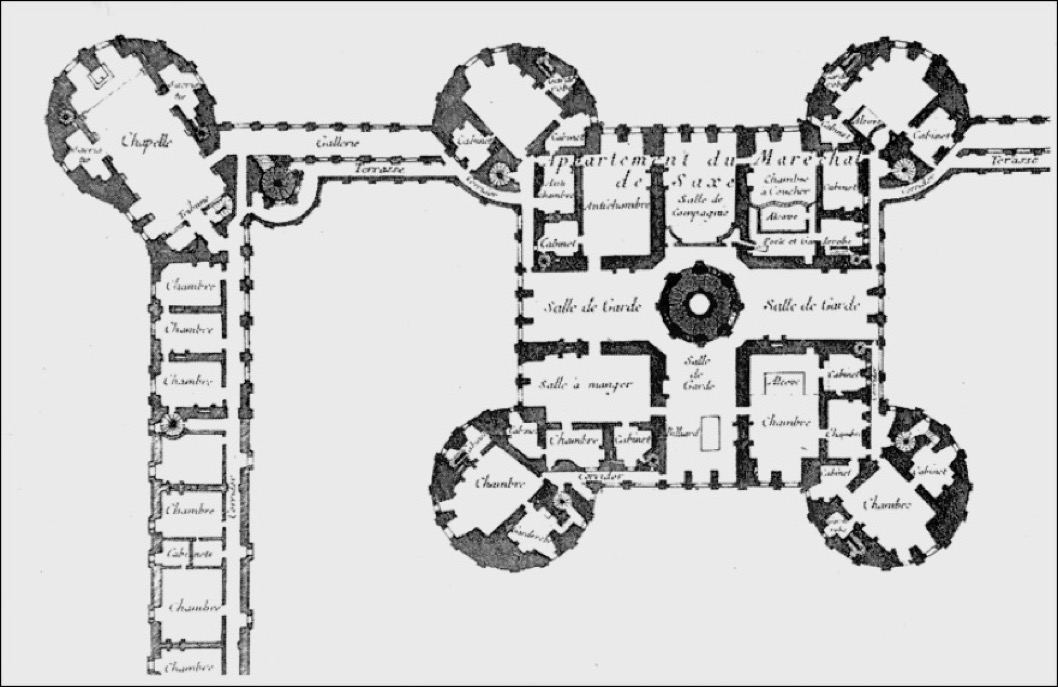
So as we walk into the ground floor (see below) we have I (entrance and guard room), 2 (Salle François Ier), 3 (Salle des Soleils), 4 (Salle des Bourbons), and 5 (the central double helix staircase).
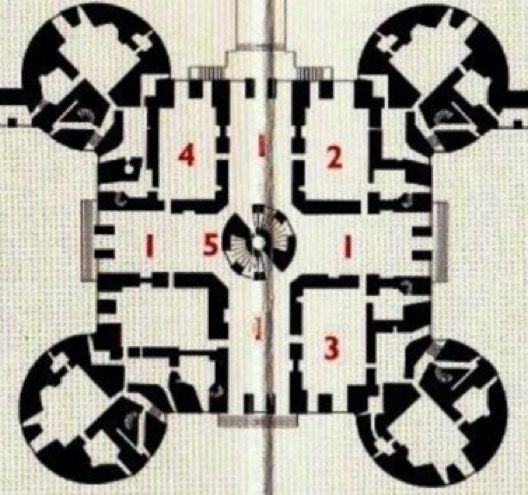
It is difficult to define what you might expect entering a château. It could be 'just an entrance hall' or it could be some grand entrance to a big banqueting hall. In Chambord the entrance is designed to focus on the double helix staircase, a kind of centrepiece of a theatrical 'mise en scène' of life in the château.

In fact no matter which floor you are on, or which room you come out of, the central double helix staircase is always there before you.
Now I will be perfectly frank with the reader. There are a number of rooms on the first two floors decorated and furnished according to some historic period. I visited each one and took photographs, I even read some the descriptions posted on the walls, etc. It left me completely cold. In Chenonceau the rooms are an integral part of the visit and of the château itself. Here in Chambord I found the rooms irrelevant to my visit. They are necessary because visiting an empty château (as I could see on the 2nd floor) is also a bit of an empty experience. So the decorated and furnished rooms are essential to the overall experience, but for me their content and historical context are irrelevant. I'm certain this is not true for many visitors. My interest was the architecture, the double helix staircase, and the 'donjon' roof terrace. For completeness, below we have Louis XIV's bedroom.

One of the recent additions to the ground floor is the 18th C kitchens. They have kept the original walls, etc. and have added furnishings, etc. corresponding to the period. Some of the objects were actually recovered from the cesspits of the château. Other are of the period, and would normally have been found in a kitchen of that epoch.
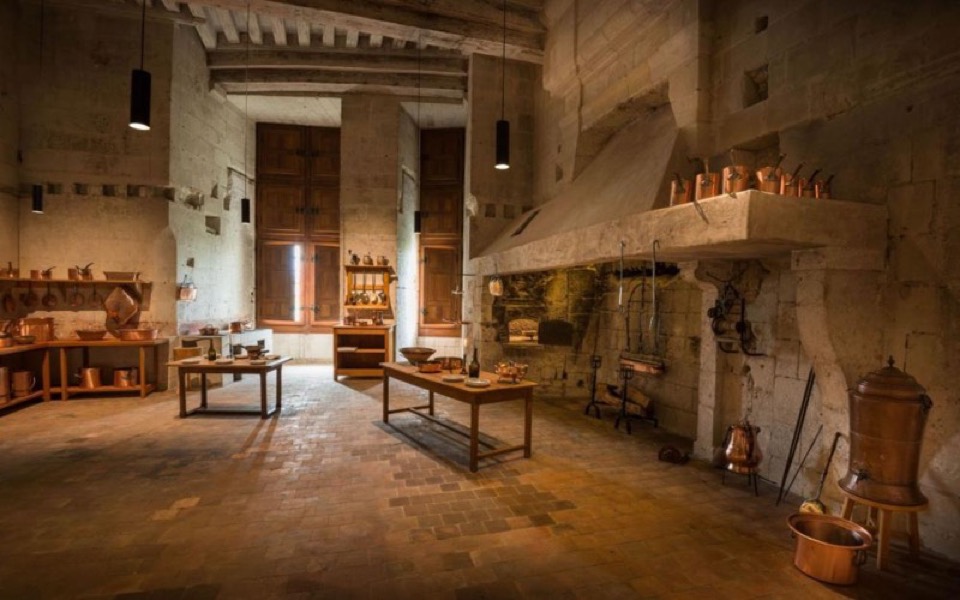
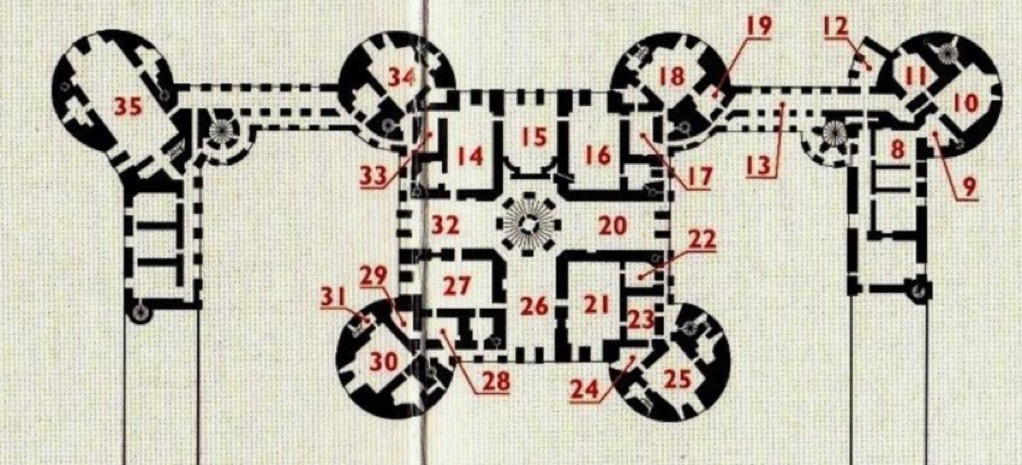
The first floor (see above) consists of:
'Logis de François Ier' with an antichambre (8), the 'cabinet' (9 or the study), the bedroom (10), the dressing room (11), the private oratorio (12) and the gallery connection the 'logis' with the official apartments of the King in the 'donjon' (13).
Apartment of the King with a formal antechamber (14) that was also the billiard room of Louis XIV, a second antechamber (15), the bedroom of the King (16), and the bedroom of the 'premier valet' (17).
Apartment of the Queen with a bedroom (18), the dining room of the Duchesse du Berry, and the guard room of the Queen (20).
Apartment of the Dauphin (later the museum of the Comte de Chambord) with a bedroom (21), a dressing room (22) two 'cabinets' or studies (23 and 24).
Apartment of the Dauphine with a bedroom (25) and what is known as the theatre of Louis XIV (26).
Apartment of the Marquis de Polignac with a bedroom that was once the dining room of Maréchal de Saxe (27), the 'cabinet des plans' (28), the 'cabinet des cartes' (29), a 'chambre à l'Indienne' (30), wardrobe (31), and what would first become known as the guard room for Louis XIV, and then the antichamber of the Maréchal de Saxe.
Apartment du Gouverneur with the 'cabinet de Wagram' (33) and the 'cabinet des Gouverneurs' (34).
Finally the chapel (35).
Frankly the first floor is almost identical to the ground floor, same layout, same type of rooms and decoration, and more or less the same view of the double helix staircase.
One distinguishing feature between the ground and the first and second floors is the presence of external galleries. If you look carefully at (say) the guard room of the Queen (20) you can see a small gallery that runs along the outside of the building and provides an alternative access to the different towers. These galleries provide a good viewing point for the different side courtyards.
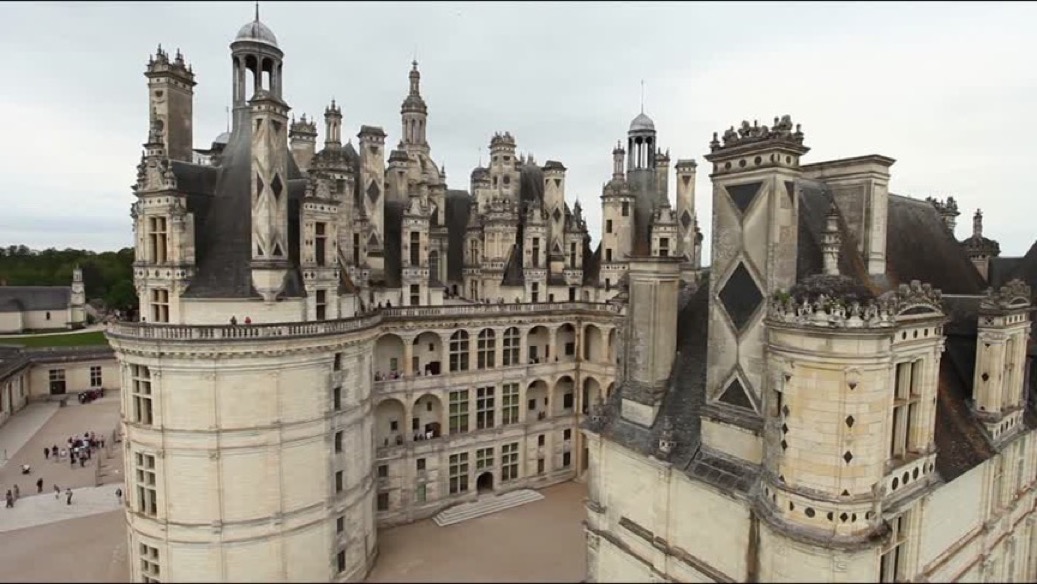
Of course as you can see below the view from the 'donjon' terrace is even better.

One the first floor we have the apartments of the King and Queen. The apartment of the King was more like a State apartment, whereas François Ier had his 'logis' just next door. What we see below is not the layout seen today. In an interesting study on the marks carved in to the stone by the masons working on the site it is possible to tell the difference between the original layout and later additions. What we see below are the parts of the 'logis' that are certainly original to François Ier. What this study did was to confirm that there was a large, and no doubt impressively decorated, 'Salle du Roi' occupying the totality of the wing.

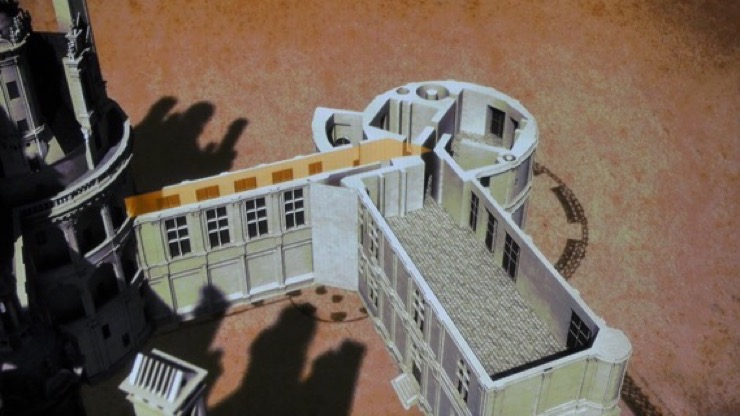
Talking about mason's marks allows us to 'spend a penny' on looking at latrines and cesspits. We mentioned a number of times toilets and latrines, and the occasional 'fosses d'aisance' (cesspit). Châteaux usually had latrines, and by the 15th century many had cesspits (although most ordinary people would still just have to chuck 'it' out as best as possible). The difference between a 'fosses d'aisance' (cesspit) and a 'fosses septique' (septic tank), is that the cesspit has no way to evacuate liquids and must be emptied regularly. Each of the towers in the 'donjon' had two cesspits of different sizes and later a small vaulted communication passage between them was created (although in some case it was later closed again with a wall).

The latrines were positioned over one of the cesspits. It was usual in many chateaux to place two of three 'seats' in a small space or room on the ground floor just above the cesspit. A second set of 'seats' would be placed on the top floor or in the roof and linked to the cesspit through a long vertical shaft. Access was provided from each floor by a small spiral staircase which ran up and down the tower 'de fond en comble' (from top to bottom). This arrangement was to avoid the smells on the 'noble' floors. Usually there was also a second vertical ventilation shaft going directly from the cesspit to the roof (this was explicitly mentioned in Leonardo's note books). Ventilation shafts were rendered obligatory in France only in 1819 (nearly 300 years later). Often the latrines would have two or three 'seats' meaning they were communal, and often they would be home to quite explicit carving on the soft stone walls (bit like today's public toilets). Fortunately by the 15th century the 'chaises percées' (close stool) had become very popular with the noble classes, and people did not have to rush up or down stairs every time they had the urge. François Ier occupied a 'logis' on the first floor, but his private latrine was on the second floor, and there was a shaft dropping down to a cesspit under the tower. This turned out to be a rectangular vaulted space, and because it was no longer used as such it became home to numerous 19th century graffiti. The size of one of the large cesspits was 7 meters x 6 meters and 2 meters high. The ground floor latrines had small ventilation windows, but most now have been converted into access doors or larger windows, and the vertical shafts are now used to house electric cables, etc.
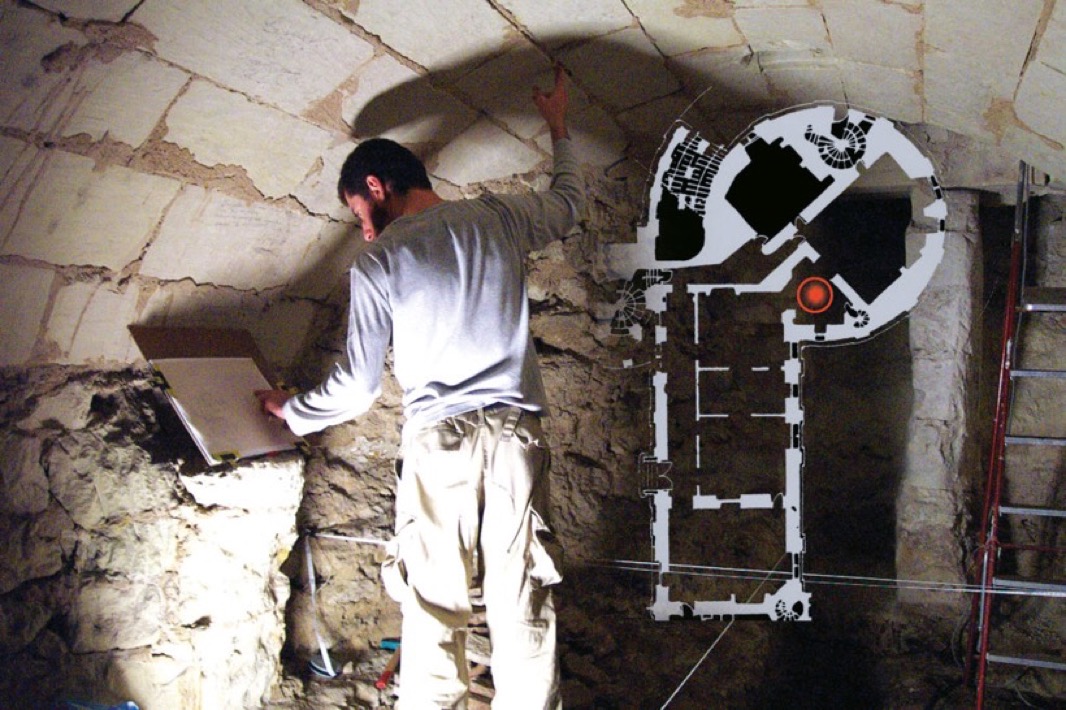
The interesting thing is in the building process the foundation were built first, and the cesspits were almost certainly the first real masonry built on the site. In addition the mason marks on the stones used in the latrines and cesspits usually remained unaltered (in particular on the vault roofing), and thus provide a valuable insight into how masons worked at the time. In addition to the signs carved into the stone, it is now evident that the masons used graphite marks and numerical signs on almost every block.
The latrines and cesspits were also used for all sorts of waste. At Chambord just in one cesspit they found more than 500 ceramic and glass fragments, as well as pipes, money, inkwells, dice games, combs, condoms ... and many culinary residues such as bones, fish scales, and oyster shells. The ceramic and glass fragments usually dated from later times, ca. 1750, probably because at an earlier time the cesspit had been cleaned out. Among the ceramic fragments they found amply confirmation that chamber pots were commonly used, and it is suggested that even 'bidets' were installed.
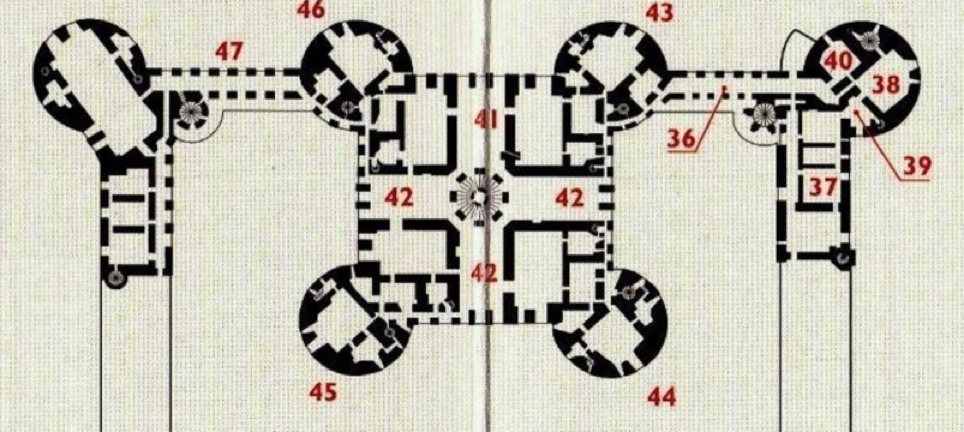
On the second floor (see below) we have:
Apartment of the Queen with a gallery (36), the old 'Salle de la Reine' (37), the bedroom (38), the 'cabinet' or study (39), and the wardrobe (40).
Rooms 41 to 47 are down as the "Musée de la Chasse et de la Nature" (Museum of Hunting and Nature).
The most impressive part of the second floor is the roof. It is what is called a coffer vault, and some reports claim that it was first used in France. The coffer means that the roof is created by a series of square sunken panels in the ceiling or vault. We usually think of a vault as some kind of arched ceiling or roof, or eventually built underground as part of a buildings foundations. We know that the stone coffer ceiling was used by the ancient Greeks and Romans. The wooden equivalent was certainly earlier and far more popular, in fact they can often be found in the châteaux of the Loire Valley. What we have here is a vaulted ceiling made up of stone coffers. The form of the vault is the barrel vault, or even more specifically the three-centred barrel vault. What this simply means is that the curvature of the vault is created by joining arcs having three different centres.
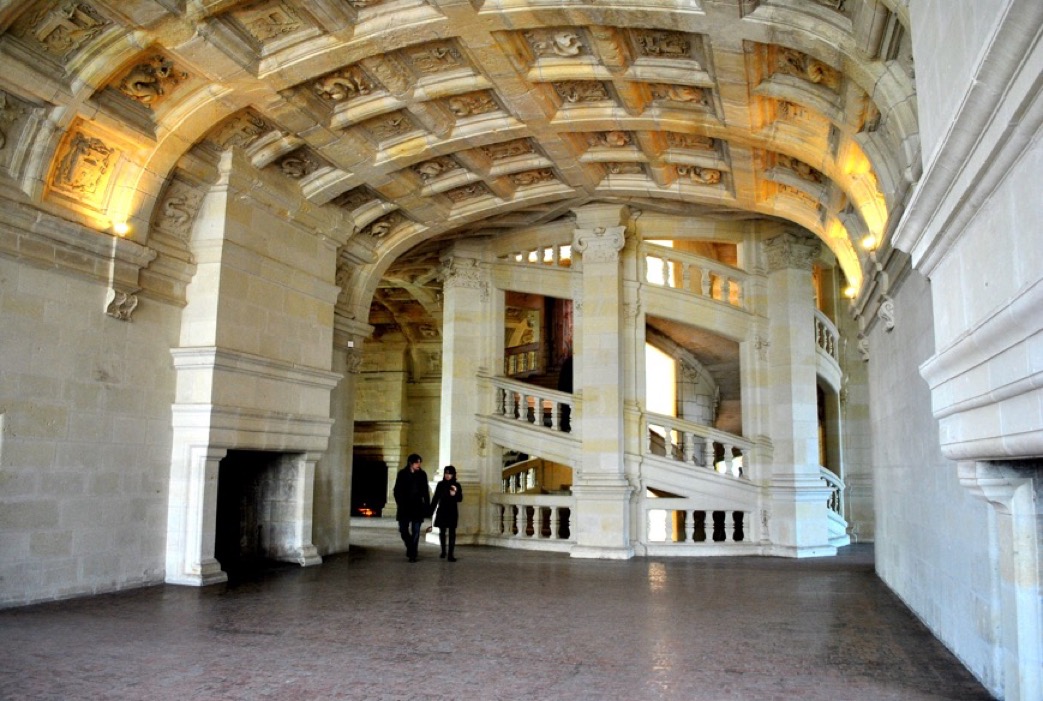

We may just be able to make out the designs in the different panels. If we look closely we will see alternatively a fire salamander and a royal cypher 'F', both of François Ier. These symbols can be seen more than 300 times each around the walls and ceilings of Chambord.
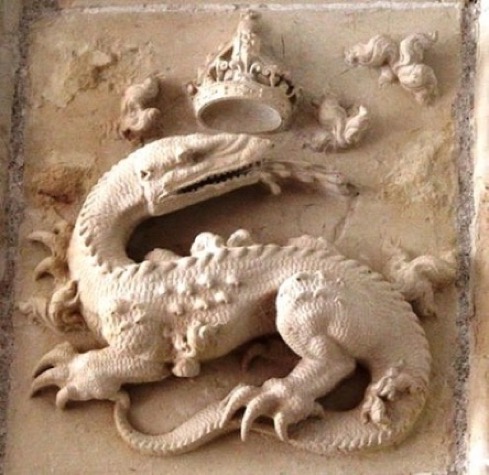
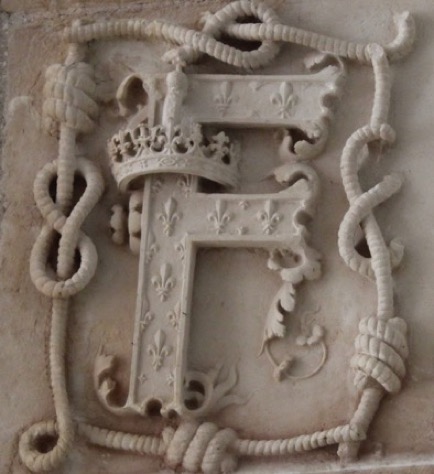
The medieval bestiary was both a compendium of animals (beasts) and a symbolic language in western Christian art. Sovereign's and high nobles would often take one of these beasts as a symbol. François Ier was not the only sovereign to take the salamander as a symbol. In Chambord he made sure you understood that it was his symbol by putting a crown on it and with the motto Nutrisco et Extingo, which means "I eat the good fire, I put out the bad".
In the Middle Ages, the salamander was seen as a magical and legendary animal. It could live on both land and water, and it was said it could resist flames. So the salamander was seen as a master of all the elements. She is often shown either spitting drops of water to extinguish the bad fire or swallowing the flames to feed the good fire.
There is a claim that each salamander and each 'F' is different. It is true if you look carefully some salamanders have no crowns, some have smoother skins other covered in scales, some thin others more monstrous, the crowns themselves can be more or less elaborate, and it is true that some appear to spit flames and other water. One of the salamanders has 'her' body covered in 11 stars each with 5 branches. People have read into the salamander all sorts of significance. The salamander had replaced Saint Michel in fighting for good against the evil of the dragon. The salamander positioned over the doors occupies the same place as the 'lamb of God' which sits traditionally at the centre of the celestial Jerusalem. Some salamanders spit water to put out the evil fire that some visitors might have when entering the castle. The symbolism goes on and on, designed to support different messages throughout the château.

The 'F' of François is often crowned, and we can see that it is surrounded by a rope with two knots tied in a figure of '8'. There are numerous webpages dedicated to the numerical symbolism of the '8' for François Ier, and I leave it to the reader to try to make sense of it. As for the 'F', some have crowns, some don't, some have more complex knots, and the crowns can be different. One of the crowns has two small salamanders set as 'florets' (I never found this one).
The double helix staircase
This is both physically and symbolically the centre-piece of Chambord. The double helix staircase is in every guidebook and on every website. I have decided to let these photographs do my work for me. If you want to know more about this particular double helix staircase, look it up on the web.
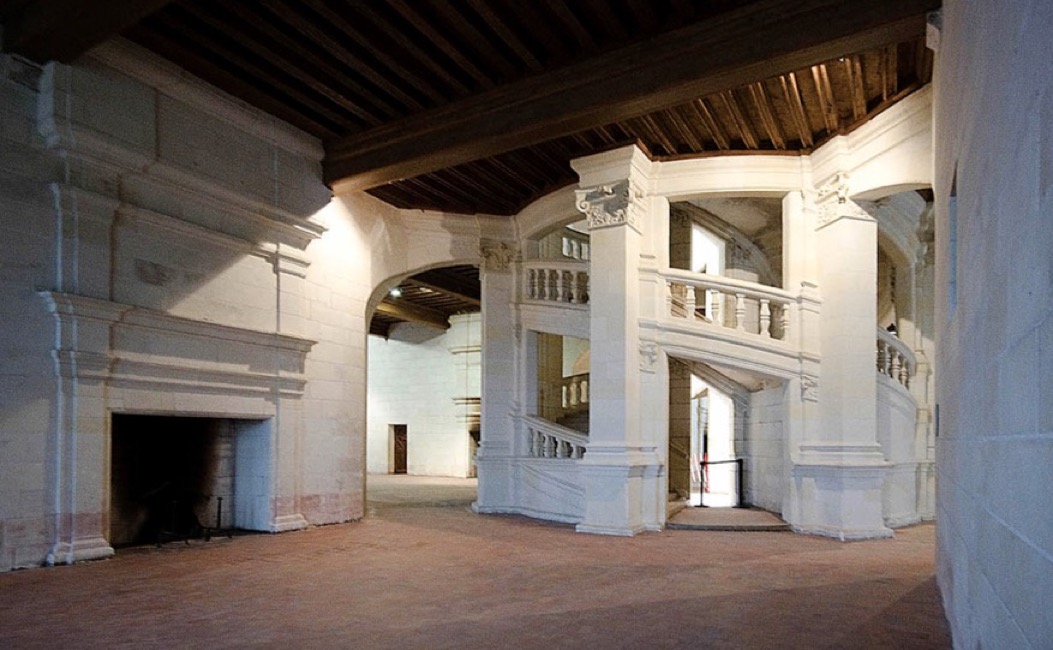


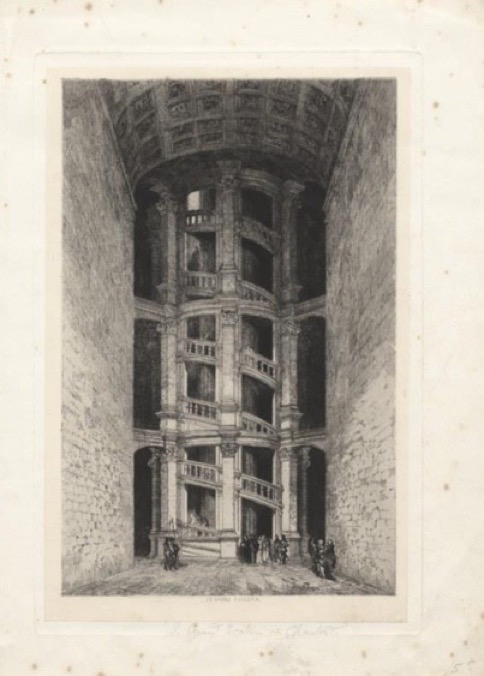

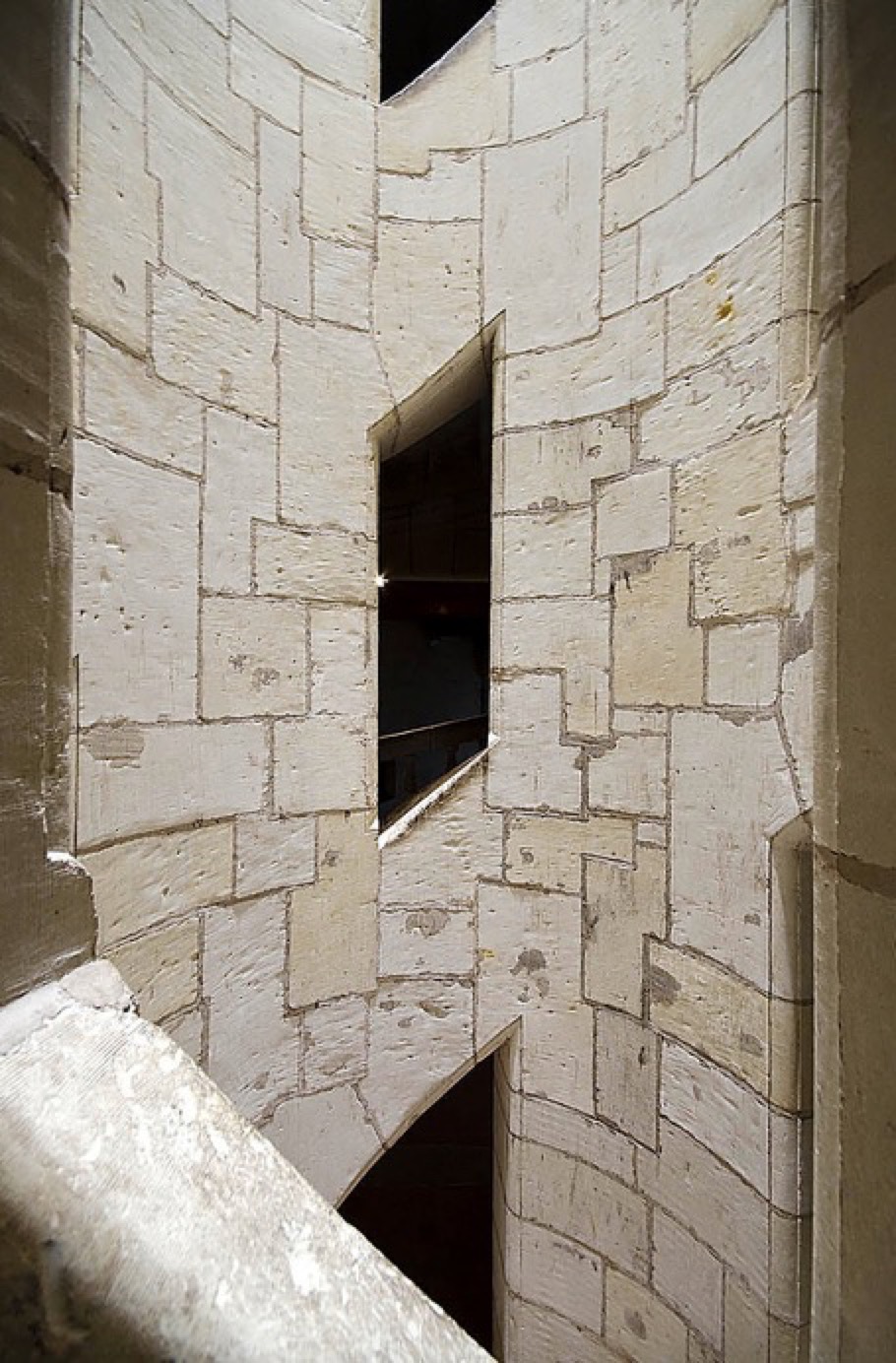


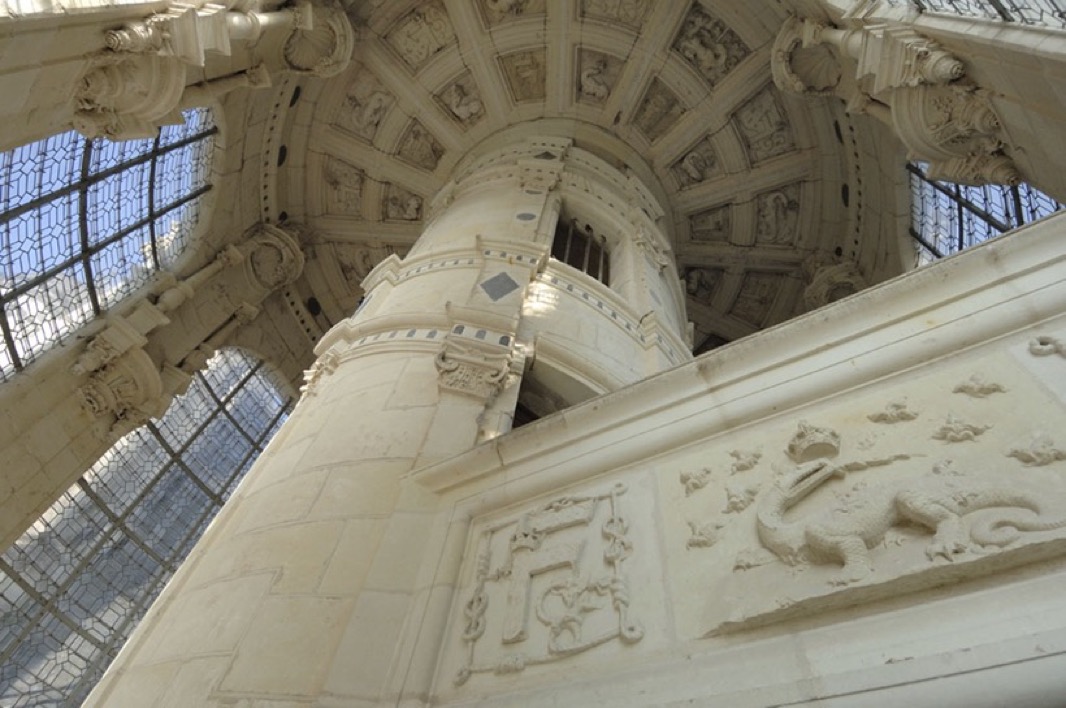
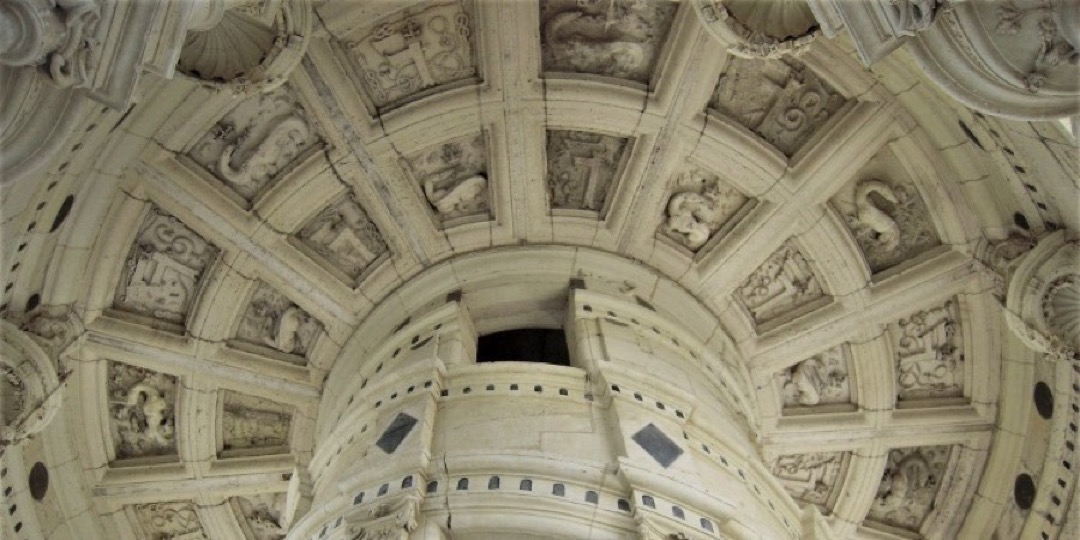
It is quite possible that the reader may never have come across the idea of a double helix staircase. It is equally likely that the reader is more aware of the existence of the nucleic acid double helix than of double helix staircases. Spiral stairs have been used for well over 2,000 years, e.g. below we can see the spiral staircase in Palazzo Contarini del Bovolo (Venice), dating from 1499, but double helix staircases are rare.

Why do spiral staircases all ascend clockwise? The orthodoxy is that there is a military advantage for the defender. Those defending the stair from above have more space for the right-handed sword arm, and the attackers would have poorer visibility and less space for their sword arm. The reality is that after about 1240 there were an increasing number of anti-clockwise spiral staircases built.
Possible the earliest building with a double helix staircase is the Minaret of Jam in Afghanistan, at 63 meters (or 65 meters) it is the world's second tallest ancient minaret. There are some decent basic descriptions around, and the archaeological project of Cambridge University mentions a build date of 1173/74. Virtually none of the more popular webpages mention a double helix staircase, however in the submission of 2002 to the World Heritage Committee there is an explicit mention of a "steep double spiral staircase" that starts below ground level and extended to the second doorway of the next tier.
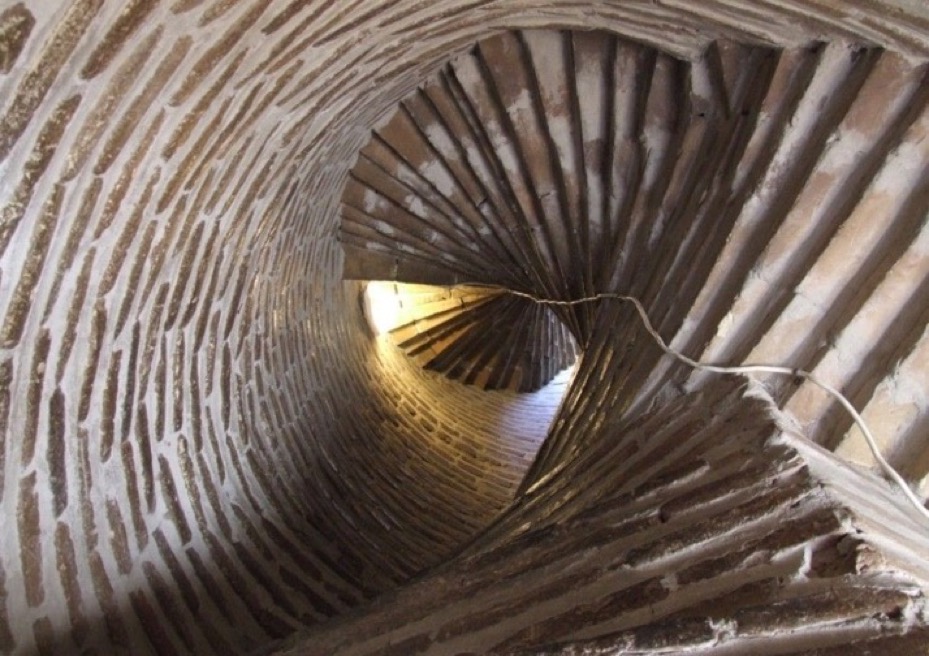
We will now turn our attention to the "Pozzo di San Patrizio" in Orvieto which is also a double helix staircase, but with a difference. It is a 62 meter deep well carved out of the rock and finished in 1537. Designed by Antonio da Sangallo (1484-1546), donkeys would carry empty buckets down one ramp and not have to pass those bring the water back up to the surface. Interestingly some texts (but not Wikipedia) mention that for a time Antonio actually worked with or under Léonardo da Vinci. The well consists of a 13 meter diameter spiral ramp going down to the water 55 meters below, the donkeys would then cross a narrow bridge about the water level and climb back up in the intertwining spiral ramp, the route being lit by 70 large windows.
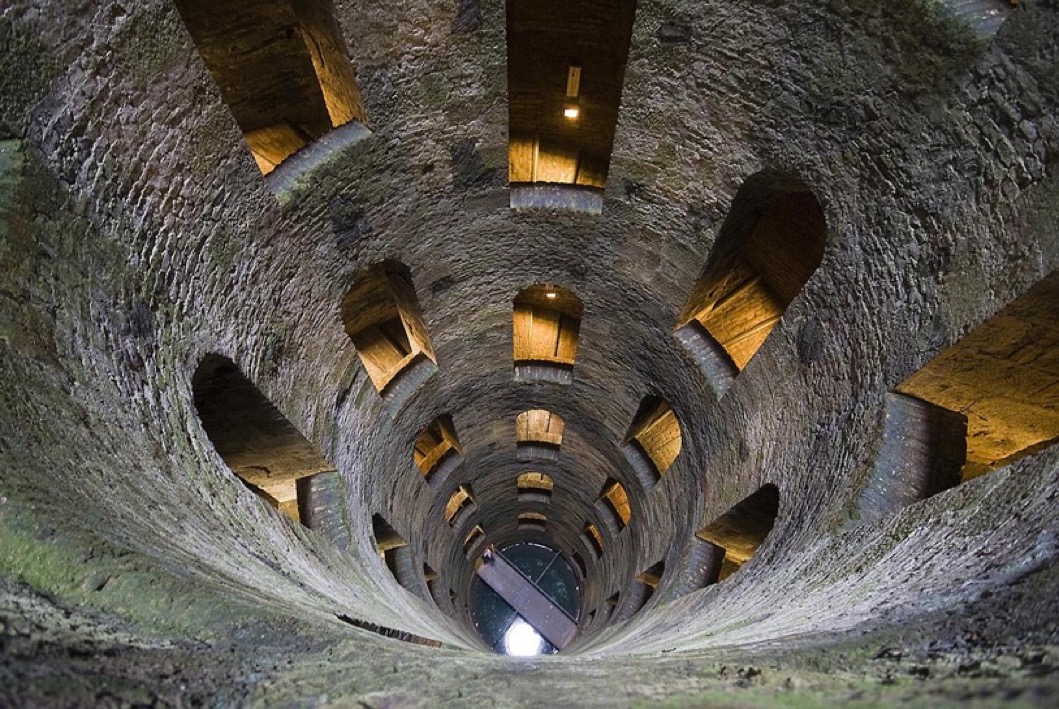
Between 1804-1807 the English built "The Grand Shaft" between the barracks on Western Heights at Dover and the sea beach (harbour and town as well) some 55 meters below. The idea was get troops down to the bottom of the cliff as quickly as possible to defend against an attack from the French. The solution was a shaft with a triple staircase. There are strong similarities with the shaft of Sangallo, except for the triple staircase, and the fact that these stairs turn anti-clockwise whereas those in Italy spiral down clockwise. This design allowed two men abreast on each staircase, so six men at a time could move up or down the shaft.
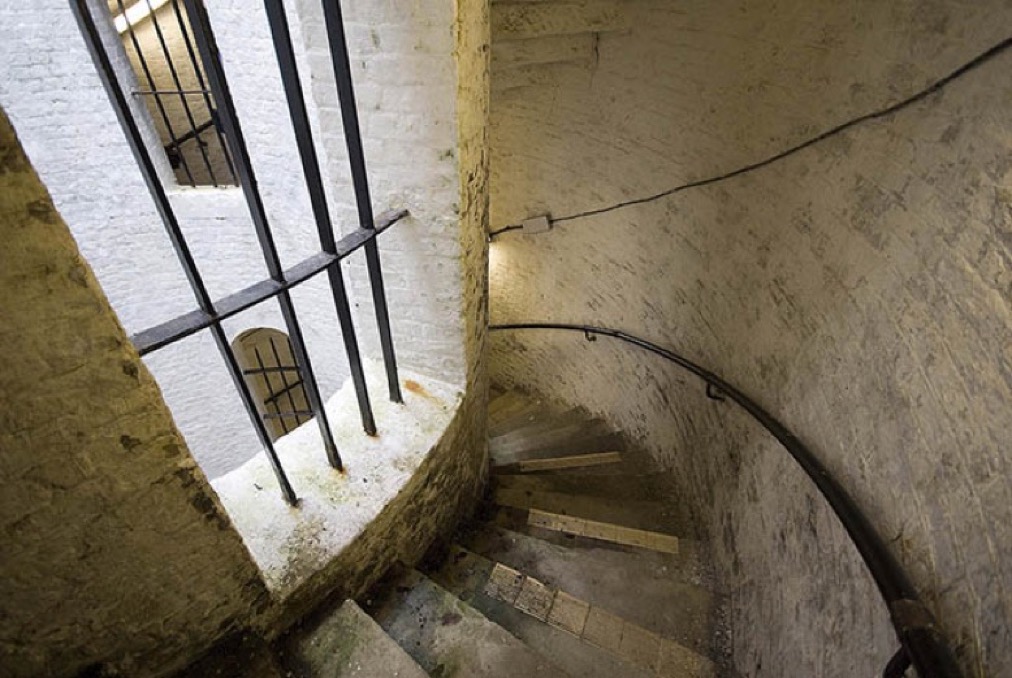
The underground parking next to the Sydney Opera House is a based upon a double helix. Here it is not the access-exist ramps that are a double helix but the actual shape of the garage itself, with the parking spaces placed like spokes off a central hub.

The roof terrace - la 'ville haute'
The claim of some experts is that the roof terrace is another of Léonardo de Vinci's inspirational ideas, based upon the concept of a city on two levels. You have the 'donjon' for the services, etc., and on the roof a promenade architecture with a panoramic view of the countryside. No matter how you look at it, the promenade around the roof terrace must be the high-point of the visit.
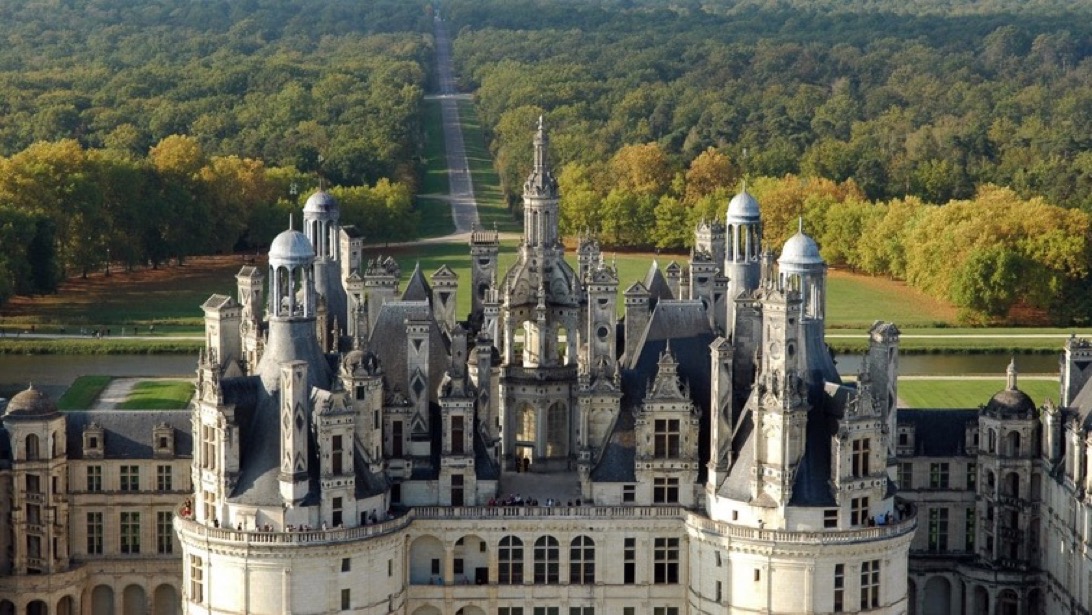
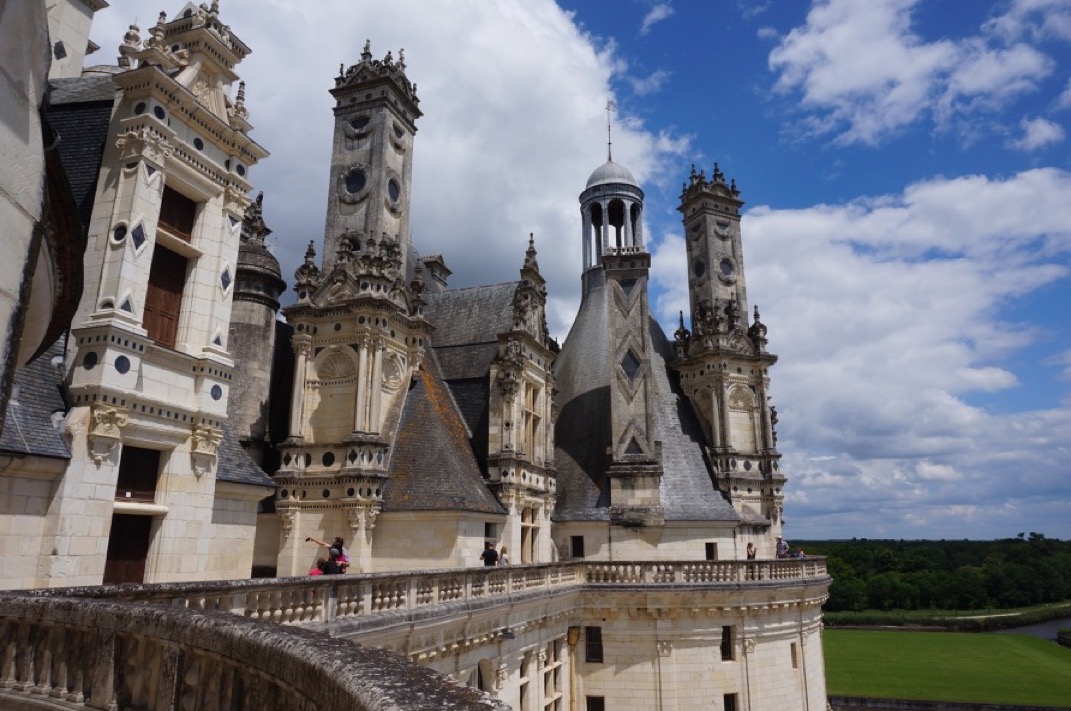
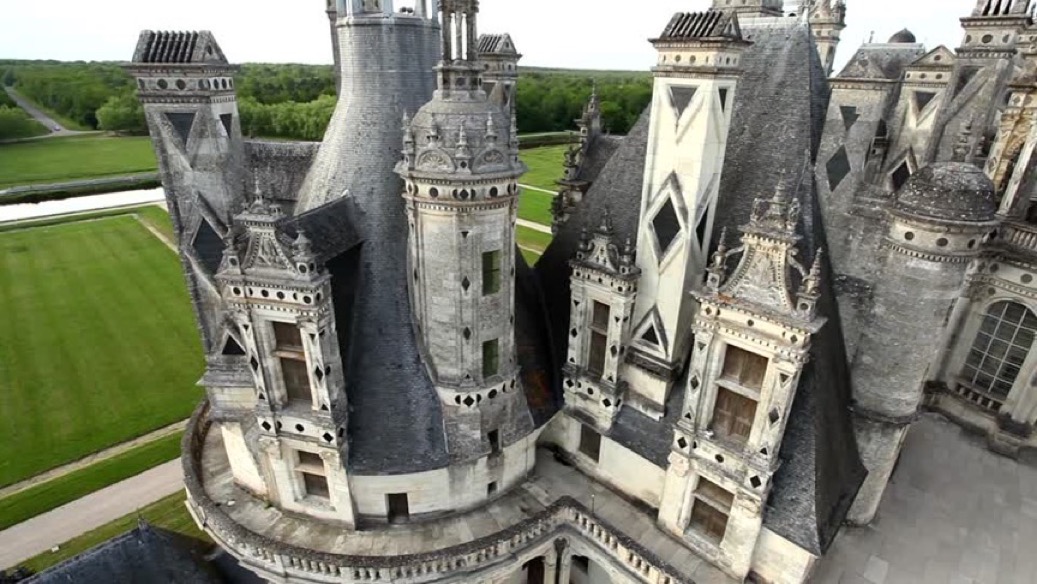
And yes, below we are still on the roof terrace…

What we see in the background is the roof lantern that provides light into the double helix staircase.
The idea of a roof promenade is clearly justified by the use of large flat stone slabs, as compared to extremely poor quality roofing found normally in the 16th century. However the slabs are of a porous stone so the sealing was made below the slabs. The technique used is the so-called 'imbrex and tegula' of overlapping roof tiles originally used in ancient Greek and Roman architecture. So as we can see the idea was that the large stone roof slabs did not touch the ceiling vault inside the 'donjon'. This was the first time this type of roof structure was built in France, and is another element supporting the idea that Léonardo Da Vinci was involved in the building of Chambord. The general idea of collecting the water under the roof tiles can be found in mountain châteaux where water was important and worth collecting.
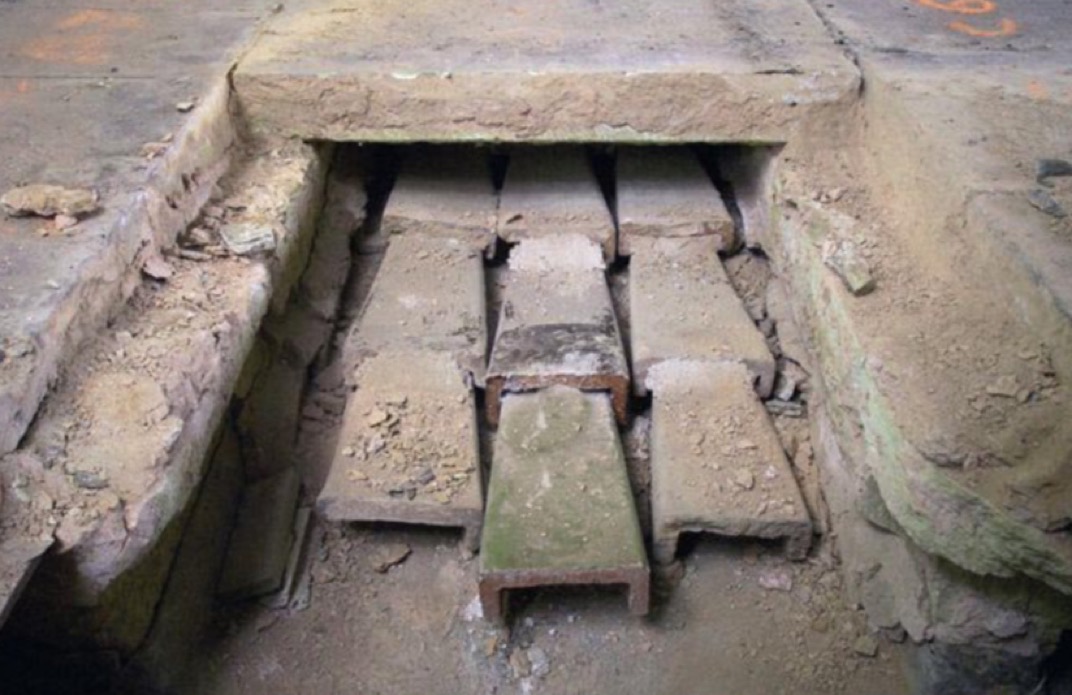
We can see above the way they used varnished tiles to carry the rainwater passing through the roof slabs into large lead covered gutters and pipes leading into the gardens. At the time the execution was not perfect. The idea was to create a space between the ceiling vaults and the roof slabs above (as we can see in the longitudinal view below). In fact about every 150 cm there is a small vertical wall linking the ceiling vault to the roof terrace, and allowing the tiles to sit independently of the roof covering. The problem was that these small vertical walls were permeable and carried water down to the ceiling vaults.

In this space the rainwater would be carried away, but at the same time the vaulting of the ceiling would provide structural support for the roof slabs. Unfortunately, as constructed one part touched the other and the rainwater leaked in through roof vaults. In the 17th C roof mortar was used to seal the roof, and late in the 19th century bitumen was used. There is record of the problem already in 1641, where all the flat roof terrace stones were lifted and replaced, and 4,500 livres was allocated for the work. In 1990 experts went back to the original idea and were able to correct the mistake and restored the water proofing. Below we can the top of the tiles, etc. once all the roof slabs had been removed.
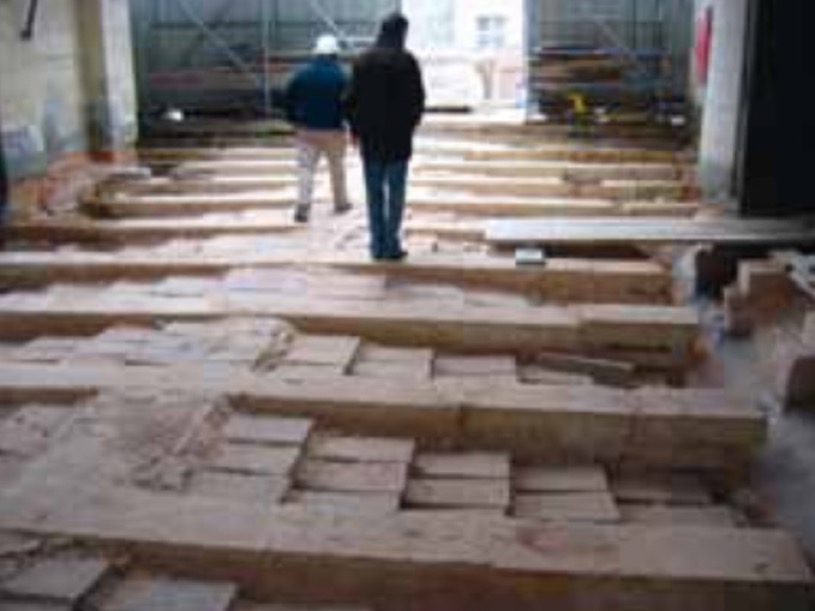
In fact the ceiling of the first two floors of the 'donjon' were 'à la française', i.e. consisting of a flat ceiling created by wooden beams. Whereas the ceiling of the third (top) floor was coffer vaulted in the shape called 'anse de panier'. The directly translation is 'basket handle' which I think means a so-called three-centred barrel arch of the form often seen on bridges. The general idea is simple, the weight on the arch of this type is partially transformed into a horizontal thrust usually restrained by abutments on either side.
Before we move on, just one more view from the roof terrace …

The involvement of Léonardo Da Vinci
His involvement in the building of Chambord appears in all the guidebooks, despite the fact that he died in 1519, the same year Chambord was started. There are no plans or written documents supporting his involvement in the design of the château, but he did live only about 50 kilometres away and was known to have been involved with the building of other châteaux in the region. We have to turn to experts to understand why we should accept that Léonardo helped design Chambord. Until recently the double helix staircase was the main justification for his involvement in the design of Chambord. Below we can see two examples, one a double helix and the other with four flights of stairs.


People have gone through all the codices of Leonardo finding suggestive drawing on building practices and designs for castles and fortresses. More generally the use of coffered vaults was typically Italian, and this type of vaulting is mentioned in the notes of Léonardo. Also we know that Léonardo knew of and was impressed by the double dome of Brunelleschi (1377-1446).
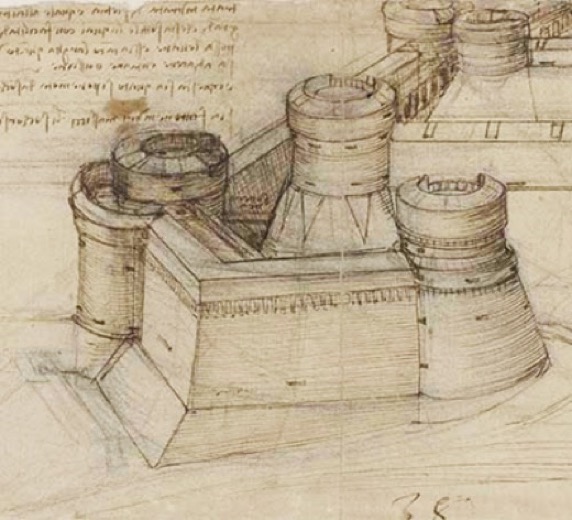

So support for Léonardo's double helix staircase is a bit vague, but if we sit back a bit we do know that Léonardo was interested in both water flow and military instruments. He would have certainly known that water exhibits a double spiral behaviour when it passes an obstacle such as a branch of a tree. We know that he designed water pumps with a double spiral that were supposed to pump more efficiently than an Archimedean pump. He designed fire escapes with double spirals so that fire could not jump from one staircase to the other. He also broke up the defences of a castle into separate portions each serviced by a different spiral in a multi-spiral staircase. The idea was that if one guard were to help an enemy, they would only be able to access a portion of the castles defences. The limited space would mean that they could never 'swarm' a defensive position.
Recently experts have 'seen the hand' of Léonardo in the building of the roof terrace. They see Léonardo in the classicism of the roof vaulting and in the way the vaulting and terrace were designed and built, however there are no examples of this vaulting technique in Léonardo's notebooks. But there are references in his notes on how to stabilise ceiling vaulting and the support of a large roof area (as with Milan cathedral), and in how to join tiles together and tie them together with roof walls, etc.
A far more inspirational but vague notion is the interest of Léonardo in the "Ville à deux niveaux" or the 'Città Ideale'. Léonardo saw the insalubrity and overpopulation of Italian cities as the problem, and developed through a few texts and drawings a city project on two levels. The idea was to separate both services and pedestrians, and social groups "In the high streets must not pass either wagons or other similar vehicles, these streets are only for the quality of people, and in the low streets will be carts and other transports intended for the use and commodities of the people".

Experts see in the Chambord roof terrace this idea of the 'high streets' ('piano nobile') for people of quality ('honnêtes hommes'), and underneath the necessary services. They point to the sophisticated system of latrines and cesspits found in the 'donjon' and the rare use of a flat stone roof sitting over a coffered vault. And rarer still to see everything placed around a central stairwell.

Looking at the variety of different chimneys that emerge from the roof, one can't but imagine the skyline of a city.

Les jardins à la française

The château as we see it today is the result of a plan initiated in 1996 designed to remove and clean away trees so that visitors could see the full majesty of the building. More recent landscaping work was designed to allow visitors to promenade around the site and view the château from all angles.
In September 2016 they started to reconstruct the 'garden à la française' covering 6.5 hectares. This was one of the largest gardening projects initiated in France in the last 20 years. As far as I understand things the plans date from the 18th C. The effort was substantial with 20,000 m2 of grass, 33,500 m2 of pathways, 2,500 m2 of bushes and flowers, 3 km of hedges, and 619 trees including 214 show or 'architectural' trees.
Below we have before and after…
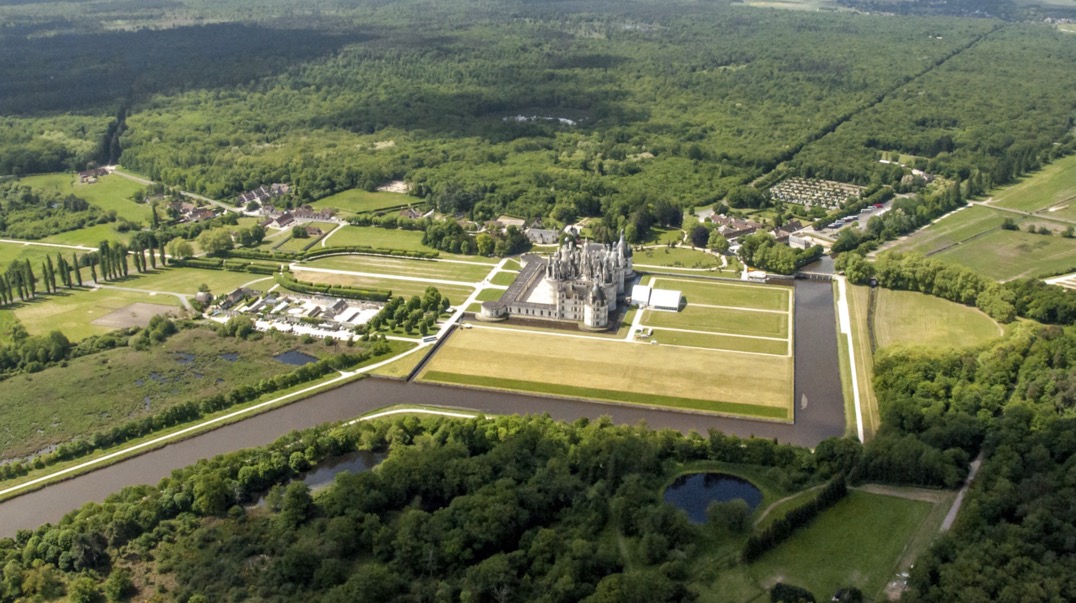

It would appear that the site is planning to produce its own wine. In 2016 there were 17 acres of Gamay planted and through to 2019 it is planned to plant a total of 14 hectares, including 4 hectares of Pinot Noir, 4 hectares of Romorantin, 70 ares of Gamay, 3 hectares of Sauvignon, and 2 hectares of Menu Pineau.
Réserve nationale de chasse
Chambord was conceived as a hunting forest, and is still today is the French "réserve nationale de chasse" for serf, and 'sangliers'. The forest is equally famous for its wildlife, and I'm told that it is also home to 665 types of mushroom.

In Renaissance times, hunting was a privilege reserved for nobles. It was part of the education of Princes and a distractions for the Court. All this has not been without an impact on the choice of the sites for royal castles, almost all are located near game-filled forests.
Deeply integrated in Court society, hunting touched directly on the image of a Prince of the Renaissance, an image of bravery, power and magnificence. Naturally the use of firearms was reserved for war and prohibited for hunting, apparently in vain since this prohibition was recalled many times under Henry IV.
In 1793 around 50% of the domain was forest, today its about 85%.
What can we say, … Chambord is well worth the detour.
References
Domaine national de Chambord, Rapport d'activités 2016
Château de Chambord, programme archéologique
Subterranean Fenestration has a page dedicated to double and triple helix staircases
Archeoforet
Glossaire of French terms
Mérimée is a database of the French Minister of Culture on historic monuments. This is a 190 page document on Chambord.
La revolution du château de Chambord (video)
Visites interdites - Le château de Chambord - épisode 1, épisode 2, épisode 3, épisode 4 (videos)